Absolver is a game that is ambitious to its core. The sights, the sounds, the mechanics, all of them reach towards something great. It is impressive, and I find it easy to recognize how hard Absolver tried to make a name for itself. I also find it is easy to recognize that Absolver may have tripped over itself in excitement in some areas, and would like to explore how and why. I would like to mention now that I will be covering spoilery material, and if you’re not up for that, then be advised that’s where I’m headed. If we’re all good with that, let’s continue.
Absolver is self-described as an online multiplayer combat game. Sloclap, the developers, do themselves a disservice by describing their game this way. It is absolutely those things, but it is better described as a brilliant 3rd person fighting game wearing the skin of a 3rd person adventure game like a cheap, old coat worn by someone for a very long time before it was ripped off their cold, dead corpse. Granted, that’s not as easy to market, but that’s what it is.
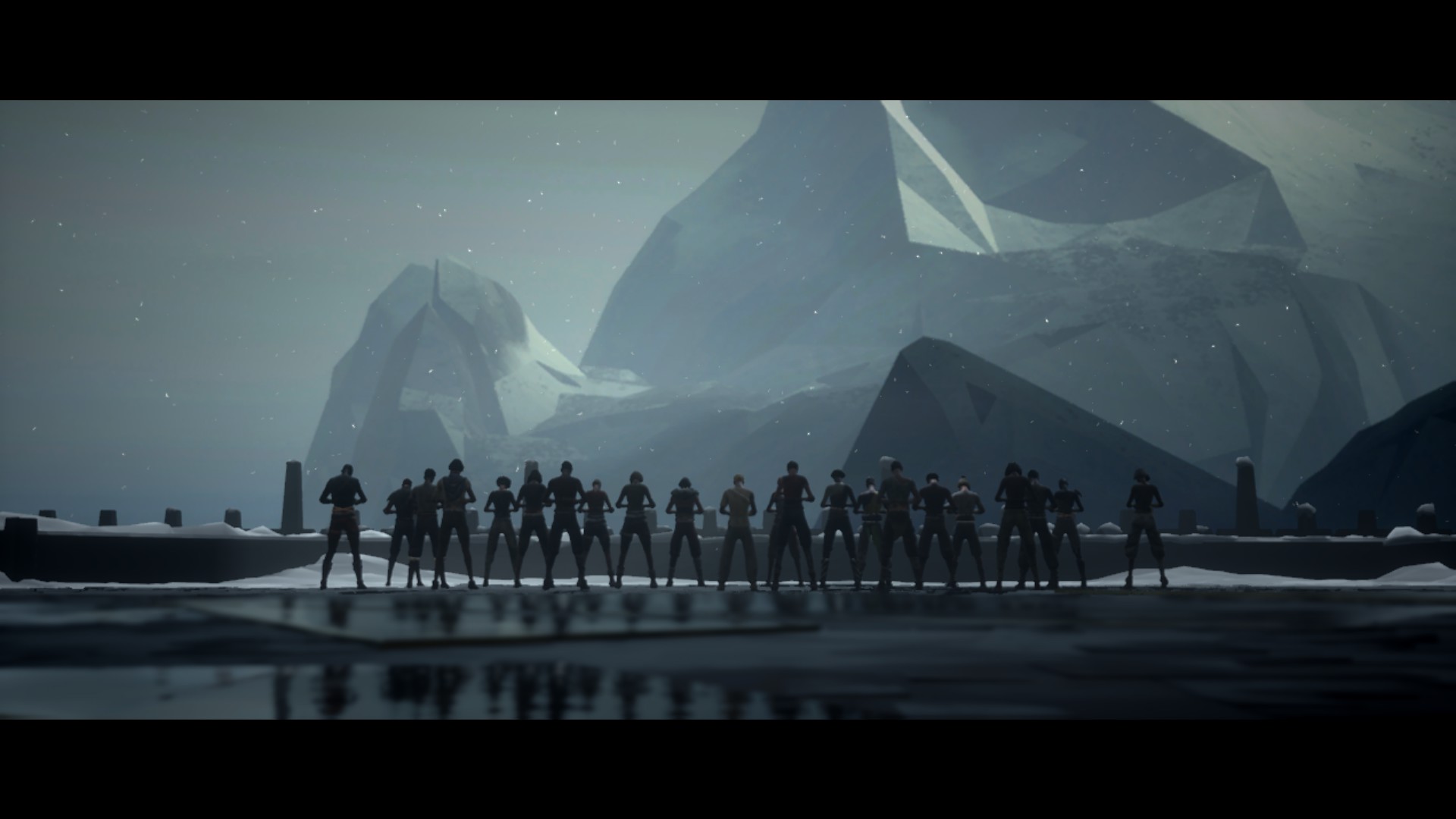
Absolver’s story takes place in a land called Adal. A long time ago, disaster struck; this disaster, called the Downfall (not very original, but functional regardless), destroyed the old Adal empire, leaving many dead and few still living. The few left living created a new ruling caste, the Guides, who live on top of a mountain. Like most old martial arts super guru hermits, they are hard to get to. The player is one of the few who have managed this journey, and taken on the role of Prospect. The Guides send Prospects back to Adal wearing a mask which removes the need to eat or sleep, and prevents the wearer from dying. As one of these Prospects, the player is chosen to go back to Adal, and prove their worth by killing a dozen “marked ones,” earning experience and leveling up along the way in a traditional action-adventure style. Accomplishing this will grant them the rank of Absolver, the Absolvers being an elite group of martial artists who serve the Guides in some way.
In short, it’s a pretty typical nobody-becomes-somebody type of adventure template. This nobody can’t be anybody, though; aside from male and female, a token variety of skin colours, and some preset hair styles, the player character is going to have the same physique as literally every other character they come across in the game. No big boned folks, or short folks; just an easily cloned template replicated across a skin-tone spectrum. This is lightly remedied with a plethora of gear and loot which the player can acquire throughout the game world as random drops off enemies, special cairns which act as treasure chests, or from combat trials.
Despite the initial lack of deep customization, the player takes a mask and is teleported back to Adal. Here, the game becomes striking; a waterfall tumbles behind the player as they wake up surrounded by sandy coloured rocks and soft grass. In the distance there’s a gorgeous blue sky and fluffy clouds. It’s peaceful. Lonely, sure, but unlike many other games that wallow in their loneliness it is pleasant and meditative. This fits well in a game focused so deeply on martial arts, and is a change from the dark and oppressive worlds of other games. Additionally, it’s a neat bit of story telling. From a cold, bleak, and desolate mountain top surrounded by other prospects to a secluded corner during sunset all by oneself. By wearing the mask, the player’s reality changes from one of cold hard reality to a soft, warm focus where sleep, hunger, and even death itself can no longer distract them. Putting on the mask is analogous to meditation itself, a practice where you set aside distractions and develop an inner calm. In this, the story finds a better hold than the karate kid set-up led us to believe. It’s environmental storytelling told competently through visual means, and it’s effective at creating an initial hook.
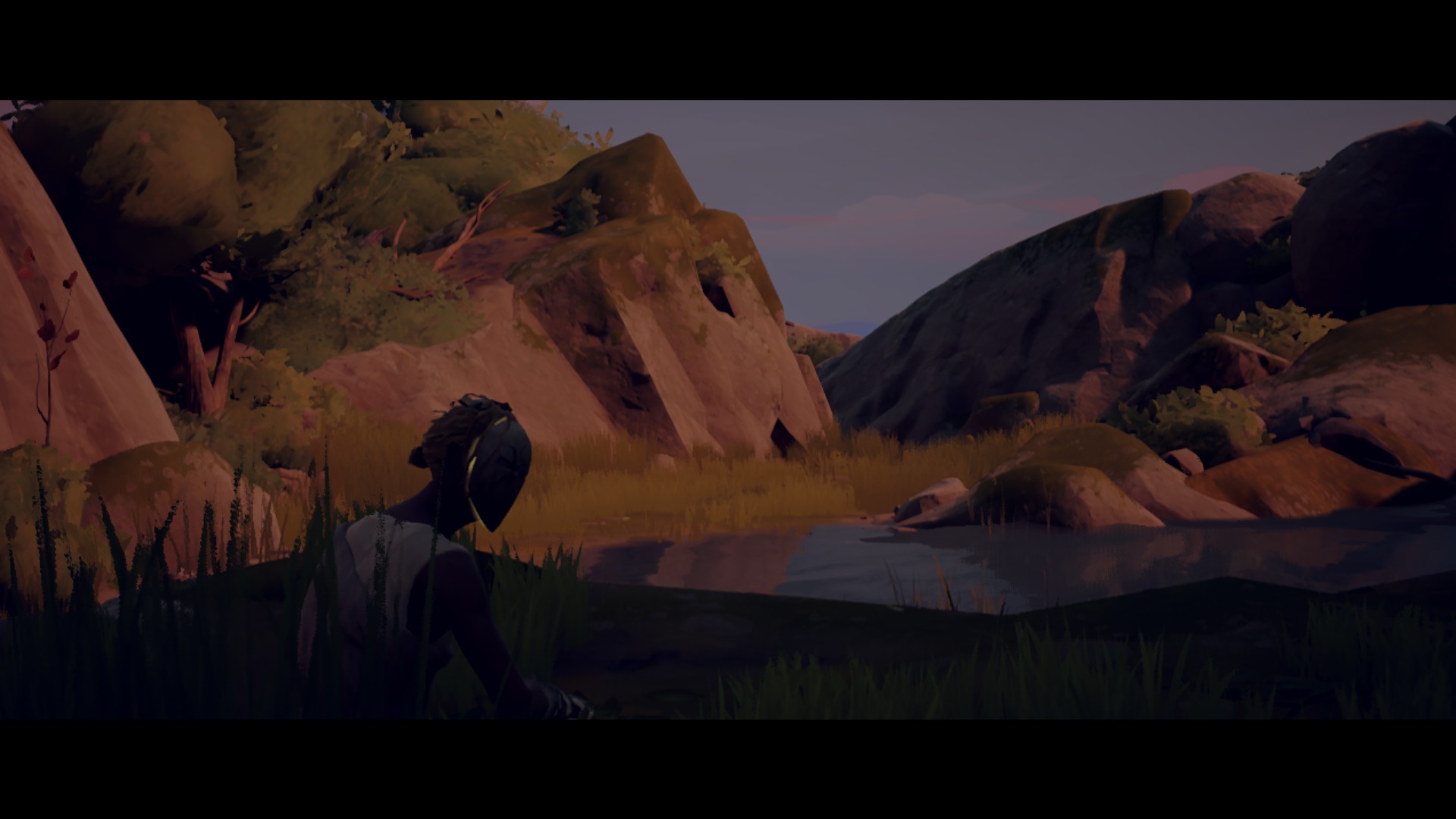
This is not the only time visual story telling is employed well. Various sections of the smallish world feature devastated fishing harbors, ruined urban areas, collapsed temples, peaceful glades, and sun drenched cliff-sides. If that sounds like a travel brochure, that’s largely the point of Absolver’s visual direction. It focusses on providing a beautiful place to get lost within. Certain areas, like the hunting path, are flat with little side-paths to explore, seemingly untouched by the devastation of the downfall. The harborfront area is the opposite, with shipwrecks having been tossed into the city proper, their splintered skeletons hinting that, whatever the downfall was, it was violent. Despite this morbid idea, the skies are blue and the forecast is sunny. Peace seems to have settled over the ruins of the old empire.
There are, additionally, some recurring characters that will show up over the course of the game. For instance, there’s some weird guy in a mask that looks like a satellite dish got stuck on his forehead. There are also; several bosses, all of whom are jerks; A drunk called Rakkio who can teach the player how to fight like him; There’s a teacher, who makes a bunch of creepy statues in the Oratian quarter; There’s also an older man who looks like one of the guides from the beginning of the game. All of these characters actually talk to the player, through text boxes, and explain little pieces of the world around them. It comes across as out of place, however; text boxes feel strange in such a visually explained world. And, from a story telling perspective, players (who wear masks) don’t have the ability to speak while NPCs with masks do? It’s practical, sure; players with shitty behaviour won’t be able to voice their crap. Still, it’s a cool idea that I feel wasn’t capitalized upon properly; there are two bosses with masks and who are largely memorable, and could easily have had their dialogue cut in a ways that would improve their presentation. It would fit with the rules of the world as well, tying players to the world in a neat and interesting way. The fact that Absolver makes exceptions to the rules it seems to impose on players creates a slight dissonance with the interesting world they’ve done up to this point.
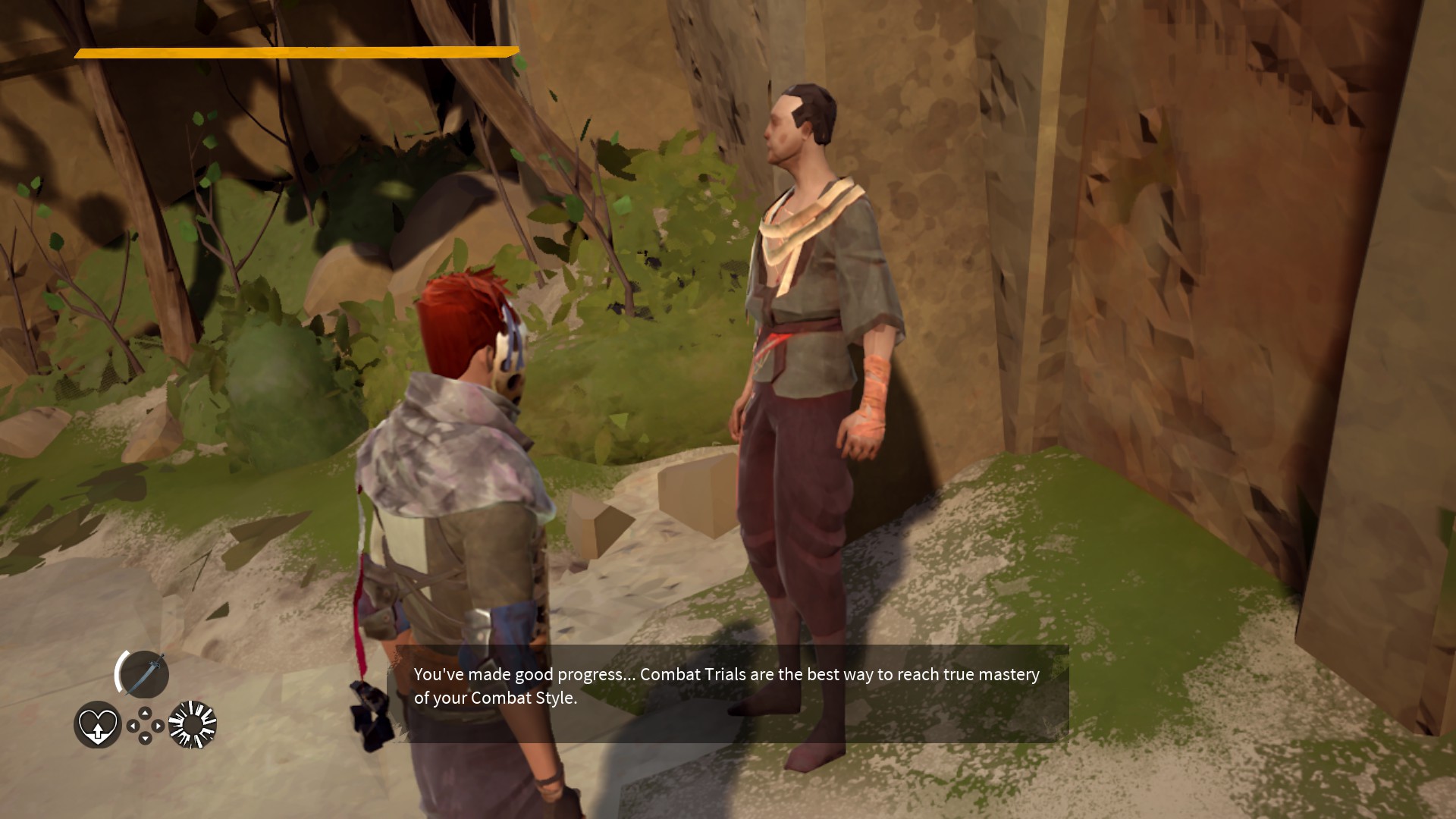
Absolver makes a choice some other post-apocalyptic/pre-apocalypse games don’t make; there’s music throughout the experience. I call this interesting since music, in large part, can make or break the exploration experience Absolver seems to be aiming for. In a surprise twist, Absolver’s music is so subdued it is at times forgettable, which is a shame to me considering who the composer is. Austin Wintory, composer for The Banner Saga, ABZU, and Journey (to name a few of his credits), was brought on to compose for Absolver. I have a deep respect and love for Wintory’s work on Journey. Gorgeous, rich, beautiful, and emotive are my favourite words that start to describe Journey’ soundtrack. It’s obvious that Wintory understands how to use music to create mood, to create an emotion and set a tone. It works especially well in Journey, where the visuals of the game are the almost sole focus of the game. In Absolver, though the music isn’t as important as it is in Journey, and it feels faded and non-essential. While meandering around different regions the player hears different themes; calm, relaxing music in the hunting path, while in the coliseum, a menacing bass (that’s… actually hilarious to me), plucks out a variation on the combat theme’s main motif. The best beats are when the player competes in combat trials, the competitive matchmaking PvP combat. Every successive round in the match ramps the tension in the music up a notch through instrument layers being added and increasing volume, creating a really memorable experience when it’s a tied game for match point. The final boss, as of the time of this writing, also has noteworthy music that fits the setting and buildup of that moment in the story. Aside from that, however, Austin Wintory’s talents seem to disappear into the background, not entirely contributing to the experience nor really detracting from it most of the time, which I feel does a disservice to the game’s potential. When the music does stand out, however, the music is wonderful, and is appreciated once one gets lost in the world.
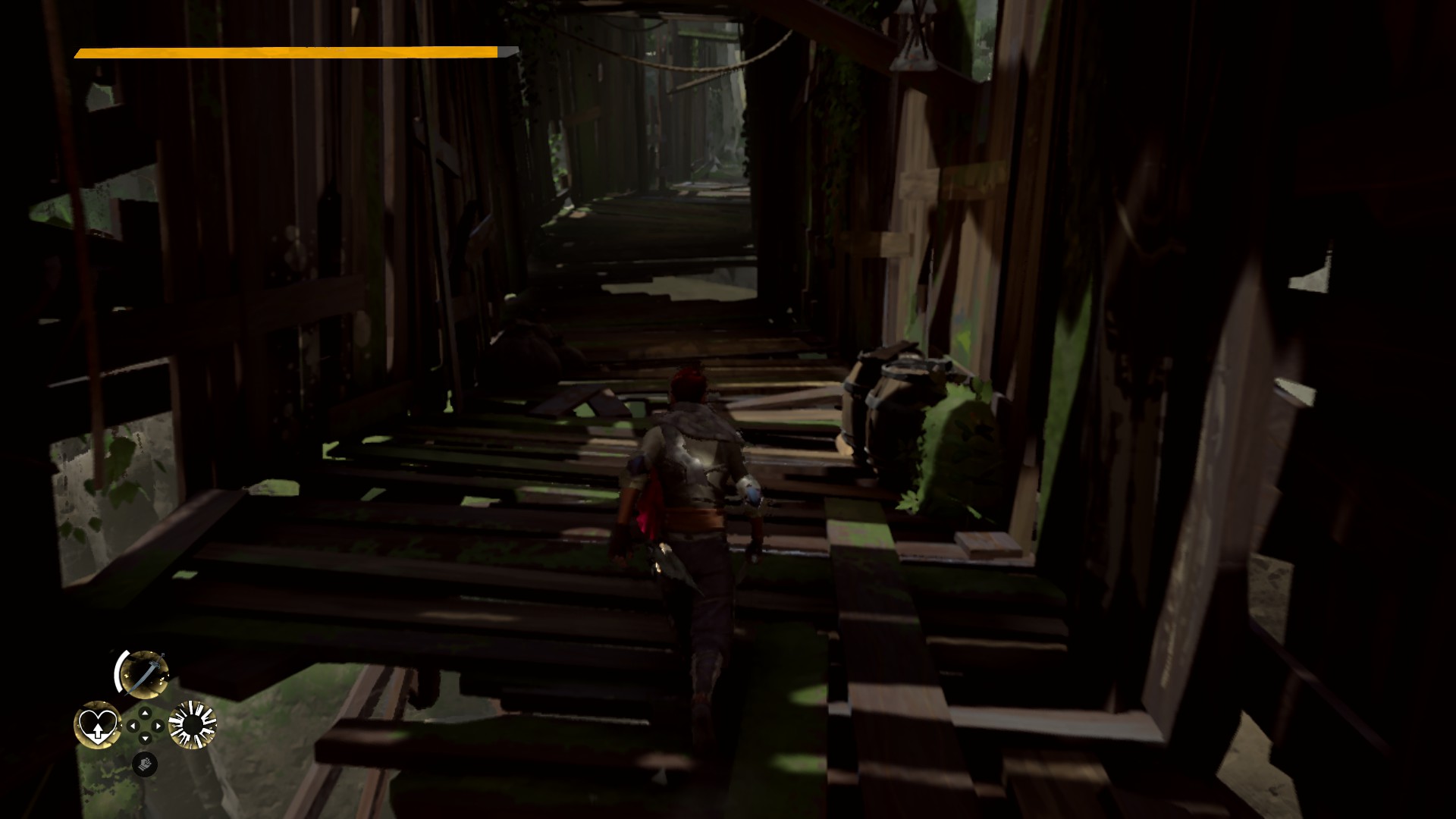
And lost the player will be. The game wants the player to learn the layout of the fallen Adal Empire by wrote, the hard-ish way. There’s no easily accessible map while exploring, meaning that while the player is out and about, they must rely on their memory to help them around. This isn’t easy for everyone, though after getting thoroughly lost in several areas, it’s not that big a deal. In a very short span of time, the world becomes relatively easy to digest. There’s one important boss objective in all but one area, and each section of the world is visually and physically distinct enough that I can’t think people will get lost very often once they realize how small it all actually is. Experiencing the world of Absolver took me 9 hours on my first playthrough. That’s not a long time. The question remains then, what happens after beating the final boss? The player is transported back to the high mountains, where they first put on the mask. The Guides induct the player into the ranks of the absolvers, giving them a sweet cloak and some instructions; go back to Adal, and continue to train until the player is needed. Players are then transported to Guidance bridge once more, and the message “YOU ARE NOW AN ABSOLVER” flashes at the top of the screen. They are free to roam once more in the lands of the fallen Adal Empire. Nothing is really that different, though they will find more powerful enemies in the wilds, as enemies scale to your level at this point. It’s anticlimactic at worst, and boring at best. It’s upsetting because the world is primed for some excellent ideas, none of which are followed up on in a satisfying way through the game itself.
The appeal of the world isn’t to do with story, then. Not really. It’s not a very big game based on content alone, but that doesn’t stop the game from standing out. There are two big factors in Absolver’s appeal that gives it a lasting and ambitious impression; first, there’s the combat system, and second, the in-and-out multiplayer aspect of the world.
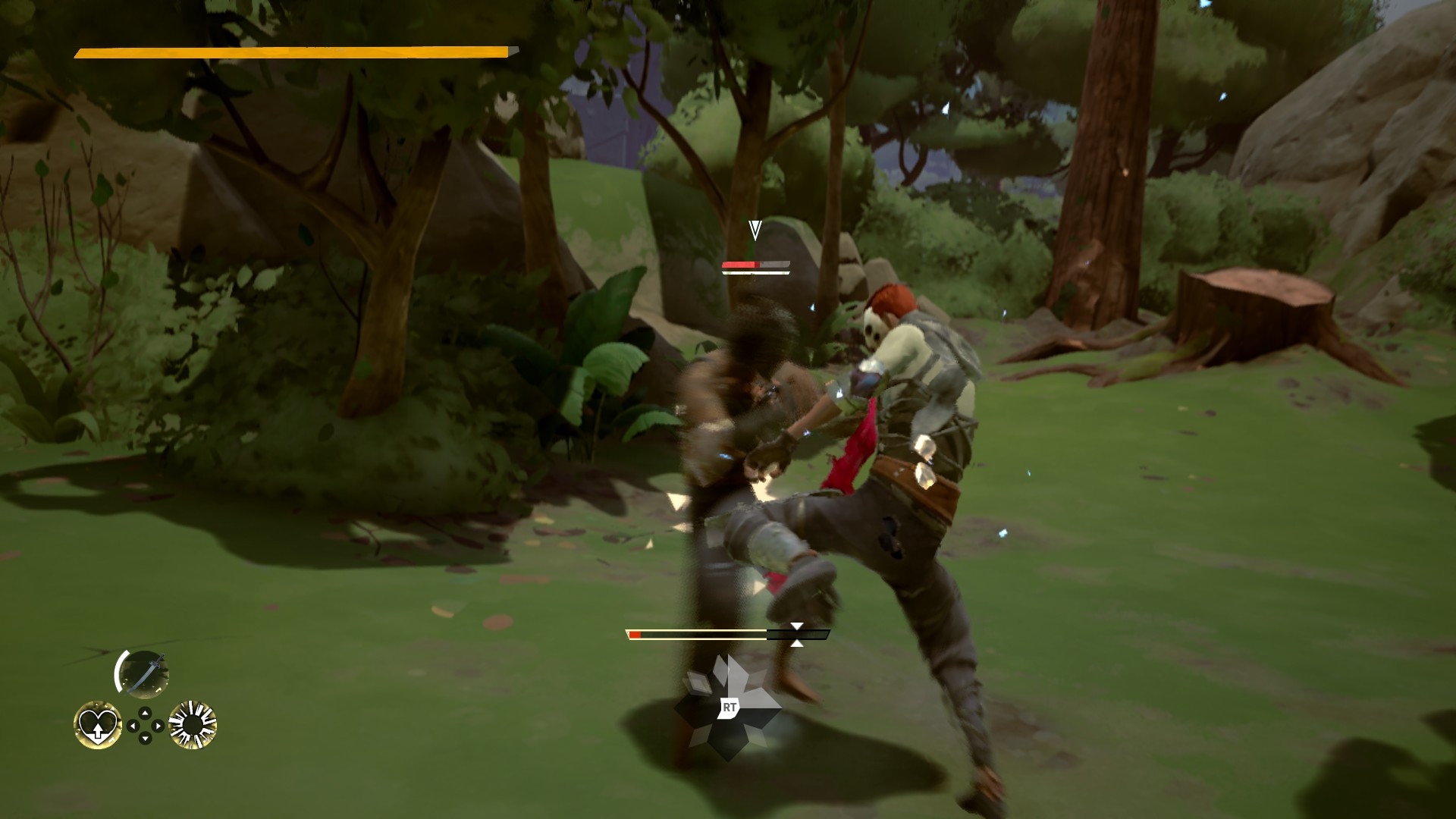
At the beginning of the game, the player is funneled into a series of routine little tutorial segments, each presenting a snippet of the combat system while presenting more dangerous situations; for instance, the player locks on to a target in the first one, attacks some non-aggressive targets after that, and so on. It’s basic, and covers each topic only once, which isn’t ideal, but does one thing in particular right; avoiding information overload by systematically introducing a mechanic, allowing the player to experience and perform the expected task, and then introducing something new afterwards. It’s easy to pick up the very basics, since the entire UI of the game is minimalist in design and engineered well, making it easy to absorb what each element does. There’s the requisite HP and stamina bars, which work as one would expect from an adventure game. The player dies if their HP reaches 0, and every action they take costs stamina, making stamina management crucial to good play. Absolver makes a couple new additions; The stance indicator, which shows the player’s position relative to their opponent as one of four options, or “stances,” and “shards,” little pieces of crystal attached to the player’s belt that glow with a bright yellow light the more the player is hurt or successfully pulls off defensive actions. These shards can be spent to cast special abilities, such as a shockwave, a heal, or to summon a weapon. And that’s it: HP, stamina, positioning/stances, and shards. The minimalistic HUD is built intelligently, keeping distracting and largely unnecessary elements like the HP bar and the shard abilities off to the corners of the screen, while stapling the stamina bar and Stance square directly beneath the player character (close to the shards on their belt) while the player is locked on to a target.
None of this is particularly new but Absolver does a great job keeping the UI elements simple and to the point; no fluff, no distractions, focusing on what is needed. The camera movement supports this; locking on to a target moves the camera from behind and above the character to down low and beside them, ideally giving a clear view of both the player and their target at all times. The stamina bar, stance indicator, shards, player, and their opponent are all within a quick glace of one another. It’s an intimate setup that works well at keeping the focus where it needs to be, on the combat itself.
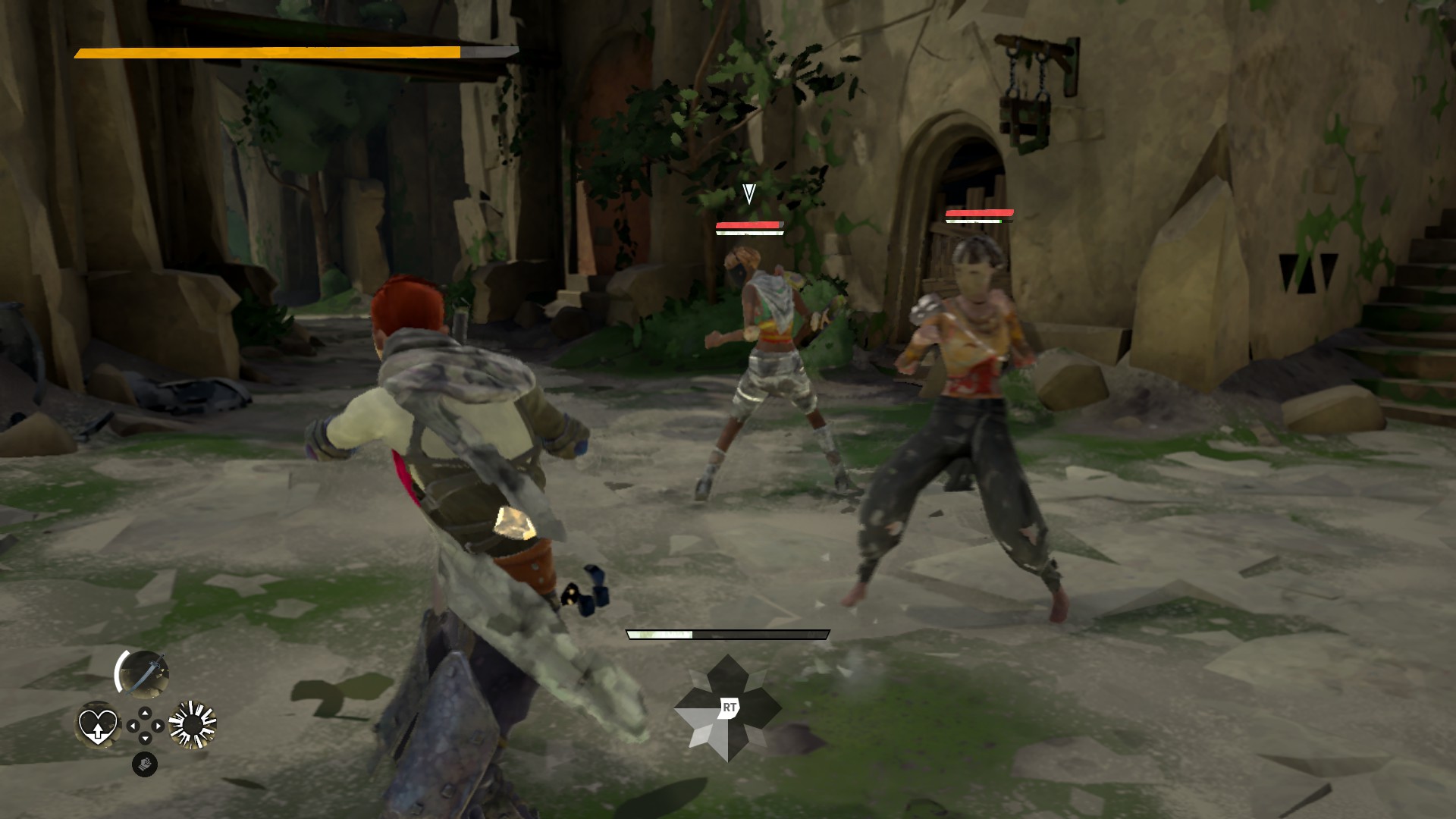
Absolver’s combat is singularly well engineered. I say this because normally, I don’t like fighting games. I always found the barrier to entry incredibly high, which is a critique that has been levelled at the genre for years. Fighting games are notorious for the high barrier of entry required to play them well enough to not feel like a moving sandbag. Skullgirls, by Lab Zero Games, is a traditional fighter with one incredibly notable development; a tutorial system, designed from the ground up to be as exhaustive and as transparent as possible. It teaches everything from basic attacks to complex, advanced techniques that incredibly advanced level players use. Transparency is only one part of accessibility, however; the actual mechanics of the game still require that players use all kinds of complex controls to be able to play at a basic level. This is a staple of the genre, and has a neat and tidy counter argument; it just requires practice. Certainly it does! It’s worth mentioning, however, that fighting games like Skullgirls, Streetfighter, or Marvel vs Capcom all have a similar problem with entry level difficulty that makes getting into the genre difficult and frustrating, especially for a someone like me who grew up on everything but fighting games.
Absolver, by contrast, has a 2 button attack system. Just 2. It’s a simple system where one button uses a chain of attacks, and the other uses an alternate attack. It’s elegant and easy to use. Despite having only 2 buttons for offense, the system itself is startlingly deep when you add the additional systems involved. Bear with me, since things are going to start sounding complicated.
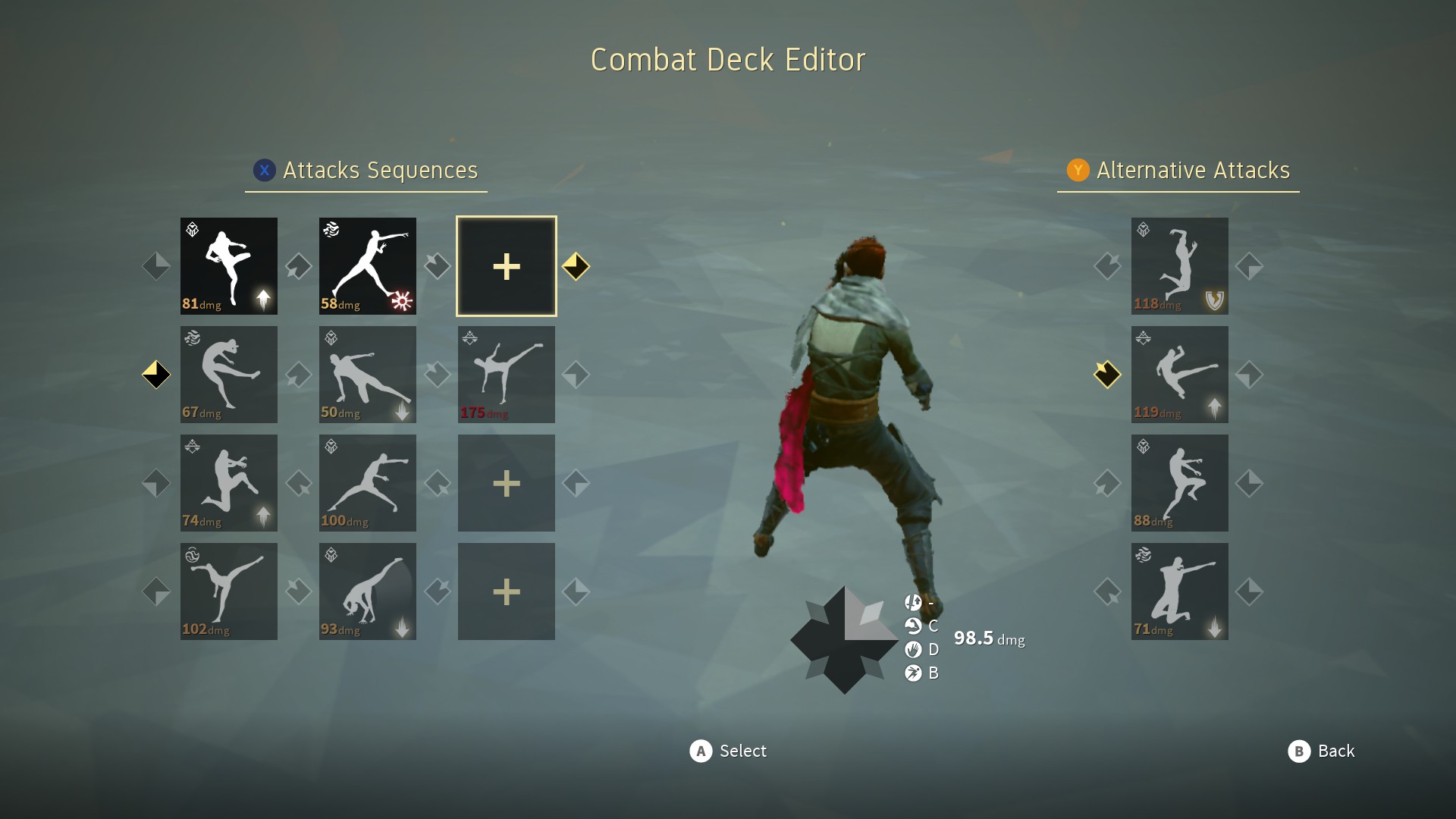
The attacks themselves are determined by something called a “combat deck,” which is effectively a completely customizable movelist. Once a character has enough experience, each stance in a combat deck can accommodate up to three chained attacks that go in sequence from left to right, as well as one alternate attack. Since there are four stances, a combat deck can consist of up to 12 chained attacks and 4 alternate attacks, for a potential total of 16 attacks in a deck. Each attack has to start in a certain stance, and ends in a different one, which allows players to chain more than just one stance’s worth of attacks in a row. Consequently, a combat deck can be built to player preference, either to flow around the entire deck for a continuous barrage or have several smaller combos, whichever the player prefers. There are so many different ways to build a combat deck that it’s either very daunting or very exciting to tinker with the huge number of options available, and I haven’t yet mentioned that every individual move in the game also has their own unique animations, power, speed, range, and can have other special attributes such as guardbreaking, super armour, or whether it can avoid certain moves during the attack, to name a few. The amount of variation possible between different combat decks is dizzying.
Thankfully, it doesn’t have to be complex; players can simply choose to have less moves in their combat deck. There’s less potential for interesting synergies and movesets, but it’s still entirely effective and much easier to work with.
What makes this system work so well are the alternate attacks, which are what allow the system to feel fluid. Players can use an alternate attack at any point during their attack sequence, which switches their stance and allows them to do an almost infinite variety of different combinations using their moveset. Even with the base number of attacks in a deck (one sequence attack and one alternate attack per stance, for a total of 8 different attacks), the player has access to a staggering number of options; and the bigger the combat deck, the more options the player has. This might come at the risk of not having the right move at the right time; still, player preference rules here, and it really is trial and error figuring out what works best for the player’s preferred playstyle.
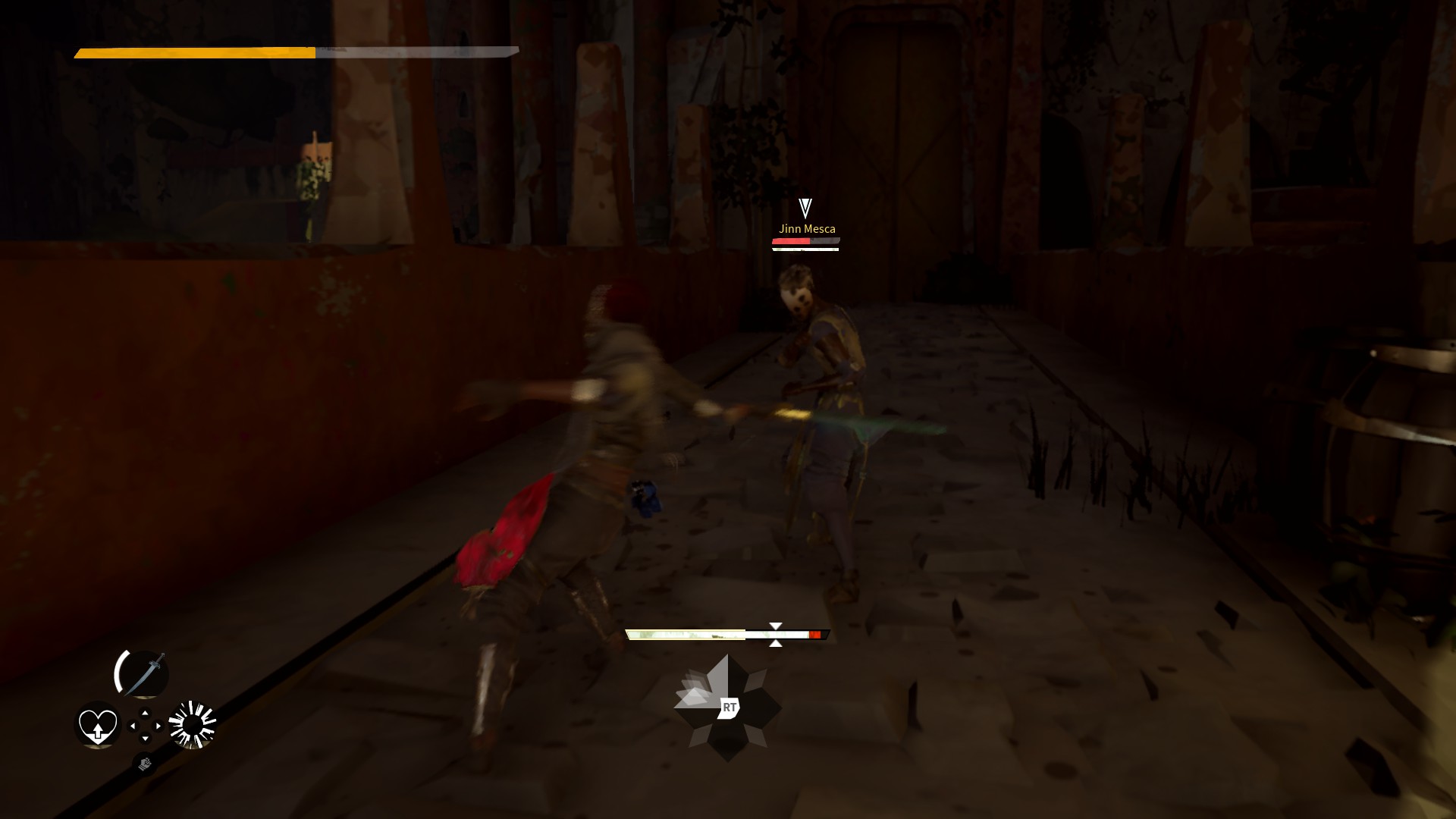
Weapons also feature in Absolver. As of this writing, you can choose from a variety of swords and “war gloves,” Absolver’s version of deadly punching gloves. You can find poor quality versions of these weapons out in the world; they are common, and are lost permanently once they break. There are also better weapons you can unlock from a few bosses in the game, or by participating in PvP combat trials; these ones are kept by the player, and can be summoned any time players have the requisite shards. Wielding a weapon does two things; first, it changes the player’s combat deck to a different one corresponding to the weapon in hand. Second, damage types change; sword weapons in particular have “cut” damage, which hurts defending players even if they’re blocking. It can be disorienting at first, but that’s the point. If a moveset becomes predictable, weapons literally add a whole new moveset to a player’s in-combat repertoire to counter that predictability. It’s a wonderful way to mix things up and inject tension into a fight. What makes weapons even more exciting is that the wielder can drop the weapon if they’re attacked enough, giving their opponent a chance to use that weapon against them. It’s great fun, and the first time an enemy equips a weapon against you is an alarming moment; it’s also amazing when you kill someone using their sword against them. The weapons break relatively quickly, however, and if it’s a player’s weapon, they must wait a reasonable amount of time before they can summon it again.
Although all that sounds incredibly complicated, it boils down to this; the player can push one of two buttons to attack. The player can choose what the buttons do before fights, and combo a variety of cool, flashy attacks in a row almost effortlessly. This is also supported by “gold chaining,” a mechanic where timing your attacks properly allows you to attack at blurring speeds. This rewards players who are practiced and comfortable with their fighting style, and punishes panicked button mashing with a slower sequence of attacks. It’s simple at the outset, but incredibly deep and nuanced, which causes Absolver to stand out amongst its genre. It’s also very satisfying, since the sounds of punches and successful gold chained attacks mix together to create visceral, powerful feedback for the player on every hit. This is especially the case on a controller with a vibration feature, which gives combat tactile feedback as well as audiovisual.
Players do not have access to all of the attacks from the get go. In fact, it’s quite the opposite; new characters have access to barely enough moves to fill a their small combat deck. Additional moves must be learned through defending yourself successfully against the attacks you want to know. It’s an interesting design choice; the only way to use a move is if you know how to defend against it, forcing the player to learn how to deal with an attack before they’re allowed to use it. If an attack was truly overpowered, or unbeatable, no one would be able to learn it in the first place. Someone using an attack has figured out how to deal with the attack, defend against it, and then beat the opponent using it. It’s also likely, due to the nature of the XP bar you’re attempting to fill, the player in question has likely defeated that attack strategy multiple times. So must you, if you want to use it.
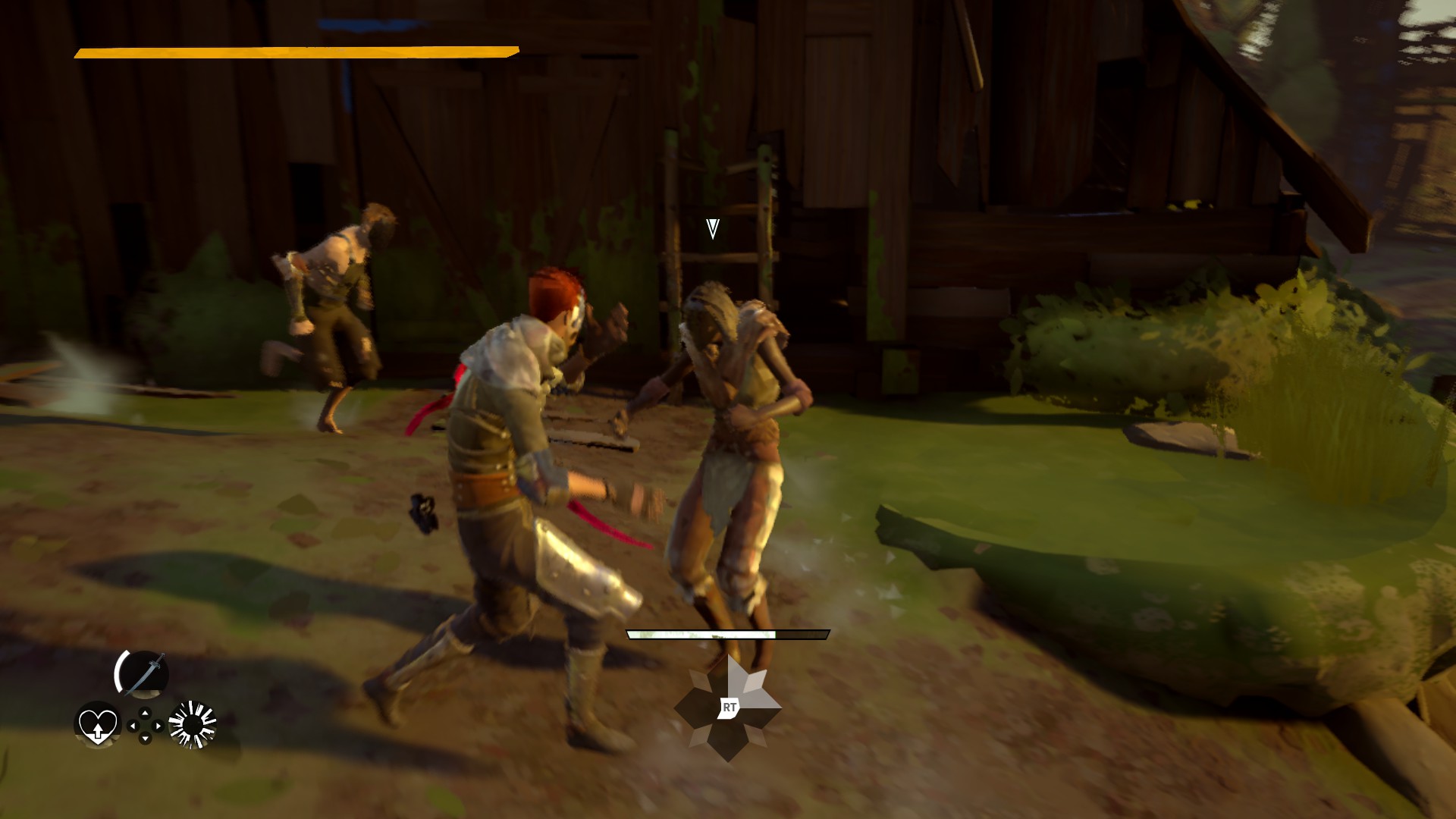
Players have 3 defensive options available to them at any time: blocking, dodging, and style defenses. Blocking is simple enough; the player blocks so long as they hold the button down. Blocking an attack costs stamina, with weaker attacks using less stamina to block than bigger ones. Dodging is a quick movement in a direction of the player’s choice. Dodging is quick and costs a small amount of stamina to use, but is has no invincibility frames. This means it’s a purely positional defense; if the player makes a mistake, it’s usually punished by the attack they meant to dodge in the first place.
Style defenses come in several varieties, unique to the style being used, though they all have the same philosophical idea: high risk, high reward. My second character used the Forsaken Style, which has access to a directional parry. If the parry was used properly, I could stop an incoming attack from doing any damage, gain a sizable chunk of stamina, and briefly stun my opponent; this opened them up to my own counter-offensive if I chose, now possible thanks to the stamina boost I mentioned before. There are a couple of catches, however; first, if I parried in the incorrect direction, the attack would just smack me. Second, the timing had to be on point; too early or too late, I’d open myself up to the attack I wanted to avoid, or the next one after that.
At the time of this writing, all of the styles have their own version of this: Kahlt users can Absorb blow after blow, Windfall users have a more precise version of dodging that can slow enemies, and Stagger users can avoid their enemy while attacking in the same maneuver. The specifics for each ability require patience and practice to learn, but they all share the same design philosophy; good usage of the ability can completely turn a fight around, at a risk.
By blocking, dodging, or using style maneuvers, you gain move experience. Blocking gives the least move experience, while style maneuvers give heaps of it instead. It’s not a bad system, but it is designed for a patient player. There might not be sufficient justification for forcing players to spend time looking around world, studying enemies, and spending a large amount of time just defending against attacks that might or might not happen due to fickle AI behaviours.
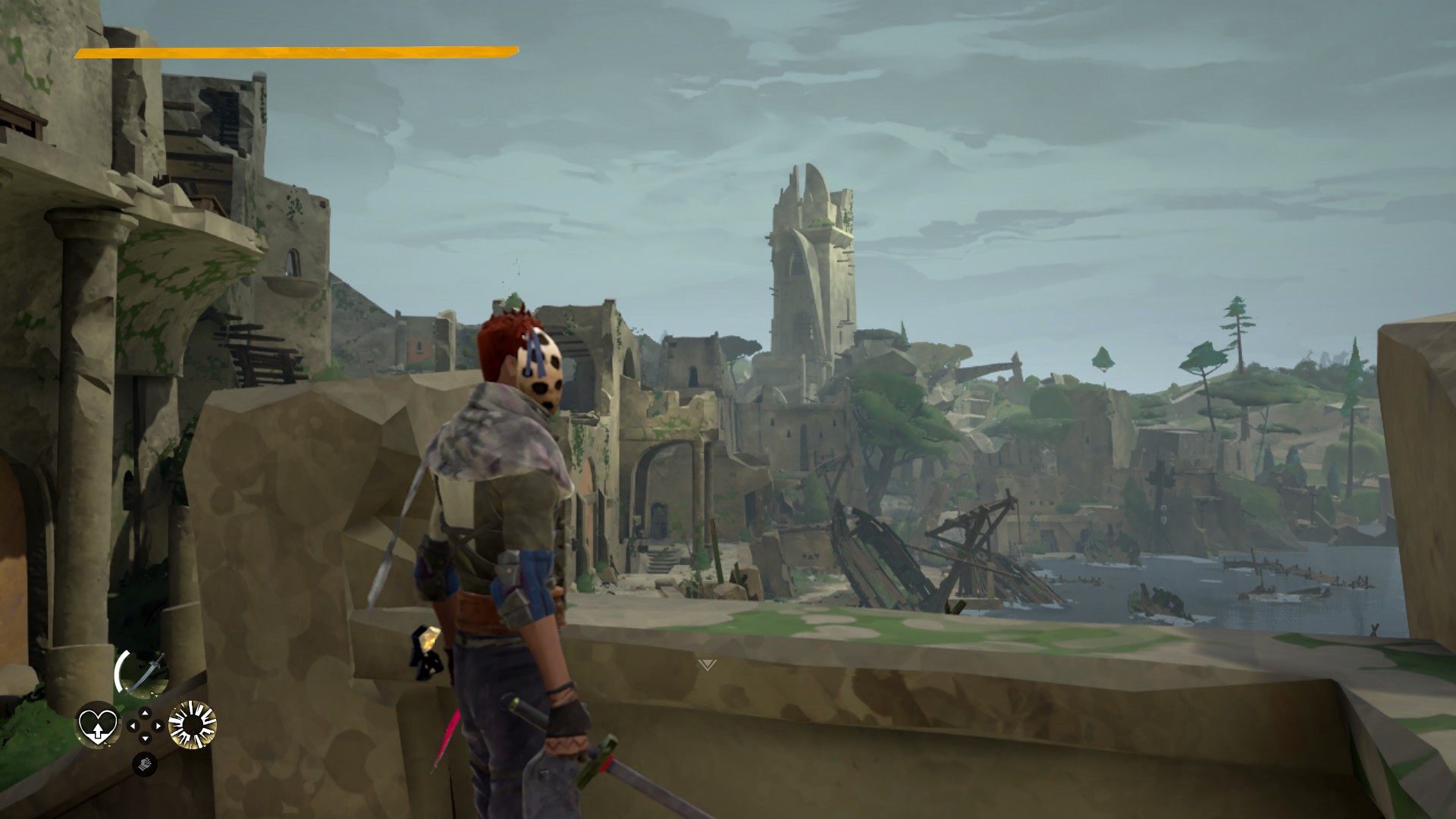
Alternatively, you can join a School for a temporary fix. Schools are the closest thing Absolver has to clans or guilds. Schools are founded by experienced players, who can then invite other players to the school as students. Students have access to combat decks provided by the teacher, which allows them to use moves they might not otherwise know so long as they use the teacher-provided combat deck. That’s all though; the unknown moves in the teacher deck aren’t properly “learned,” and are unusable outside of the provided combat deck. Schools, then, are designed as systems to provide a way for newer/less experienced players a temporary shortcut to more powerful moves, or allow experienced players to learn new combat styles. In short, if you want to learn something permanently, you have to do it the hard way.
What this all boils down to is a combat system that’s easy to start off with, but introduces a incredible number of options as players get more into the game. It’s easy to get invested at the start though; as well as the great visual and aural hook at the start, the mechanics beg to be explored, and the mechanically satisfying combat almost carries the game entirely.
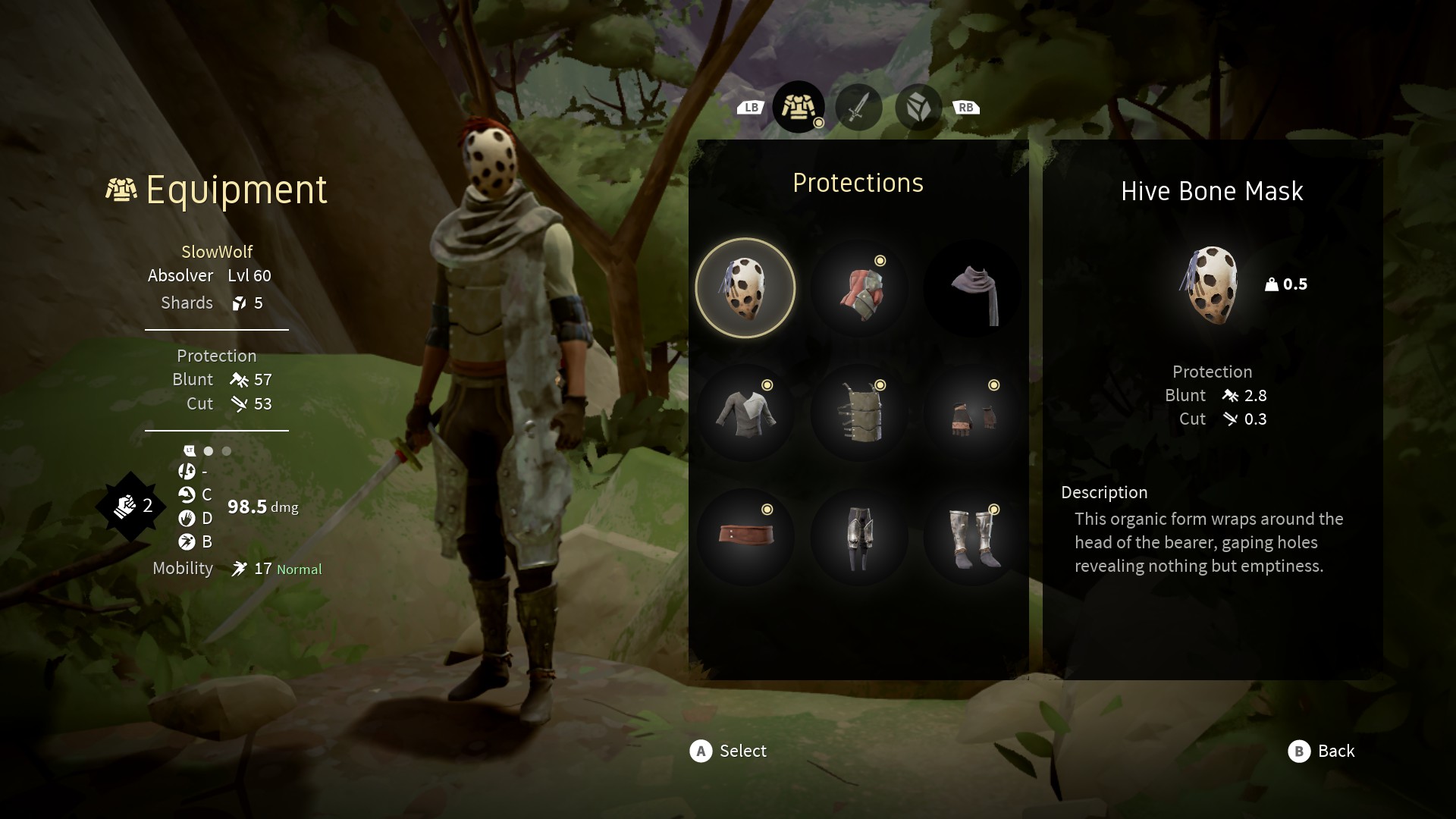
As an additional note, the clothing the player wears also affects their combat prowess in 2 different ways. Clothing protects a player, obviously; the heavier the armour, the more protection the clothing affords. This can help reduce the damage of enemies a significant amount, and it’s one of the few ways to reduce weapon based cut damage. Clothing is also the sole way to change the character’s mobility rating, which affects the damage of mobility based attacks and stamina regeneration. Typically, a player wearing heavy armour will recover stamina more slowly and deal less damage than players wearing lighter clothing. It’s a neat design choice as it means that newer equipment is not objectively always a good idea to equip, but it does somewhat lessen the excitement of discovering new items. This causes a problem that I’ll get into soon later, but in the mean time, just remember that new gear isn’t always a reason to celebrate.
The multiplayer is one of the most marketed parts of the game, and for good reason. For one, Absolver is a fighting game; fighting games thrive on the competition between players first and foremost. As a result, there are the matchmade Combat Trials, which are accessible at any altar in the game world. At the time of this writing, there’s only a 1 v 1 combat mode available in the combat trials. Sloclap have announced a 3 v 3 combat mode coming as free DLC in the near future, and additional modes later on down the line; but those aren’t out yet, and as a result I can only speak to my experience in the 1 v 1 mode.
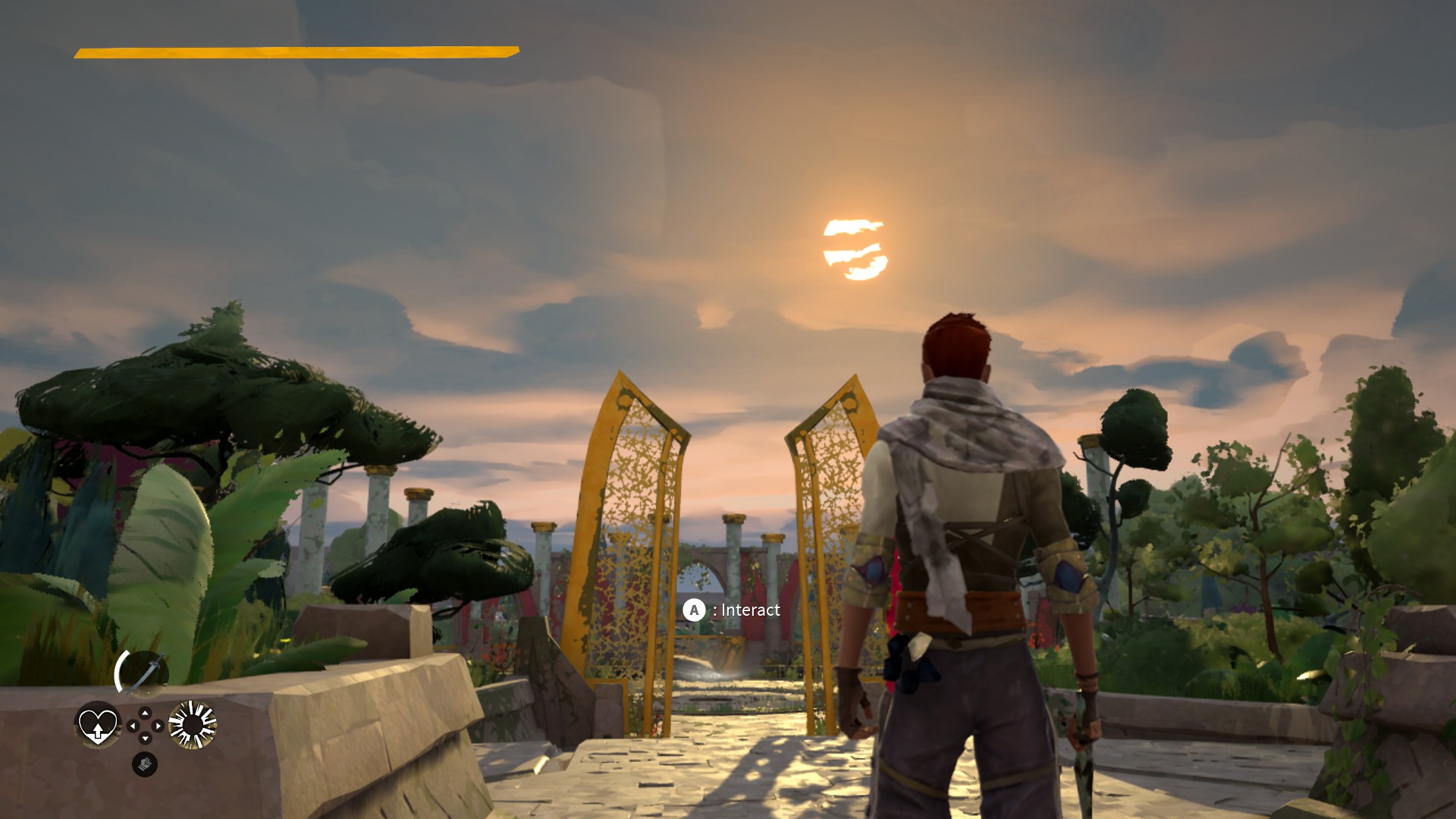
The 1 v 1 combat trials pair the player against an opponents of similar character level in a closed arena closely resembling or taken directly from the game world. The matches are decided as a best of 5 to the death, every kill netting the victor a point and some HP if they were missing any. These matches, once you get used to playing against humans, are exactly what Absolver’s combat mechanics were built for. It ramps the fighting game elements of Absolver up to 11, bringing out the very best of the combat system. The stages are varied as well; you have a couple flat arenas with no environmental dangers, as well as others with large pits, staircases, and cliff edges. It recreates the same feelings I had watching “Crouching Tiger, Hidden Dragon” as a kid, and it’s awesome. When you have a good match, it really feels like a cinematic experience as you dodge and weave through your opponent’s attacks and they do the same. It’s something I’ve never been able to experience in a video game before.
This isn’t all the time though. The 1 v 1 matches suffer on occasion as the level based matchmaking is not a good indicator of skill level. Sometimes an almost new player will be paired against someone who knows exactly what they’re doing, which results in your typical one sided stomps. For all the effort that went into engineering a simple to use, hard to master combat system, Sloclap’s incredible work is still subject to an entry level barrier that the tutorial doesn’t properly prepare a player for competitive PvP.
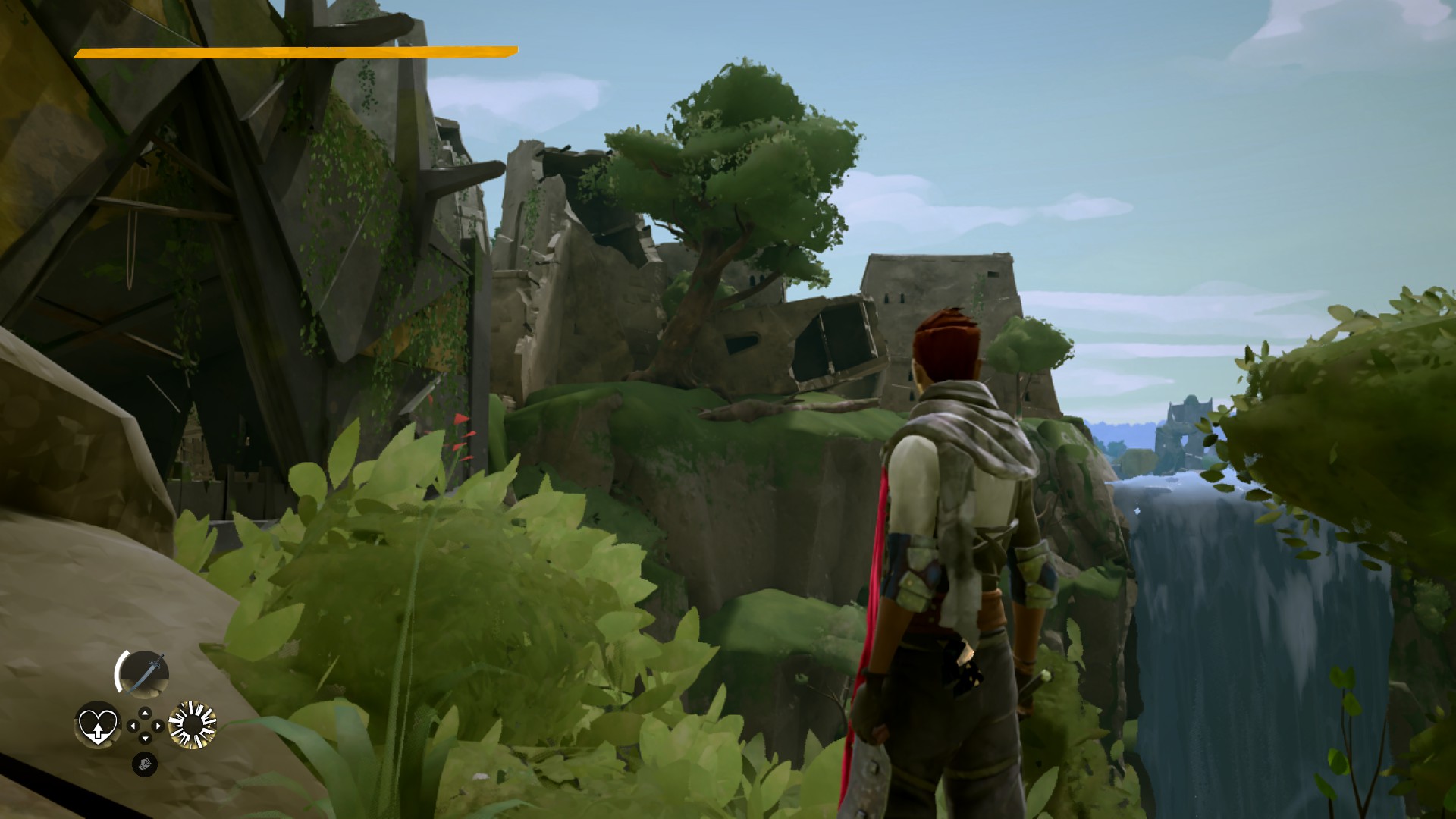
The tutorial of Absolver really shows how lackluster it is when you consider how little it teaches you on its own. Once you reach guidance bridge, you’re expected to figure everything else out by yourself; the cold, unintuitive menus, the strangely organized equipment, the somewhat unexplained attack sequences, weapon statistics and damage multipliers… it’s a lot to ask. Even if I’m being generous and lumping an entire playthrough of Absolver’s story as a tutorial for how to play the game properly, it still brings players shy of a really good way to learn the game since CPU enemies tend to be far less aggressive than players, as well as having easily understood combat patterns. Human players, especially good ones, can attack relentlessly with mixups that are difficult to decipher. There’s a massive cliff in required skill which makes initial forays into the combat trials largely a negative experience if you’re new to fighting games as a whole, or used to the Adventure Game pace of the world of Adal.
Despite this, the Combat Trials are central to the longevity of Asbolver. The only way to fight the most important PvE bosses again for their loot and story exposition is by participating in trials. At the end of a trial you gain pips; 3 for winning, or 1-2 for losing depending on how close it was. Every 5 pips you collect, you gain a combat trial rank. You must acquire enough of these ranks to earn the right to rematch a PvE boss, which is a design decision that forces players into PvP situations to experience the world of Adal fully. If I’m being cynical, this is to help bolster the online matchmaking system and focus the playerbase where Sloclap wants, rather than letting them do entirely as they please. This is further reinforced by the fact that you can avoid all the PvE content if you like and still level your character, as are also awarded character experience that you can use to level up normally from combat trials. It’s a shame for me, since I’m definitely more of an adventure game player than a PvP player.
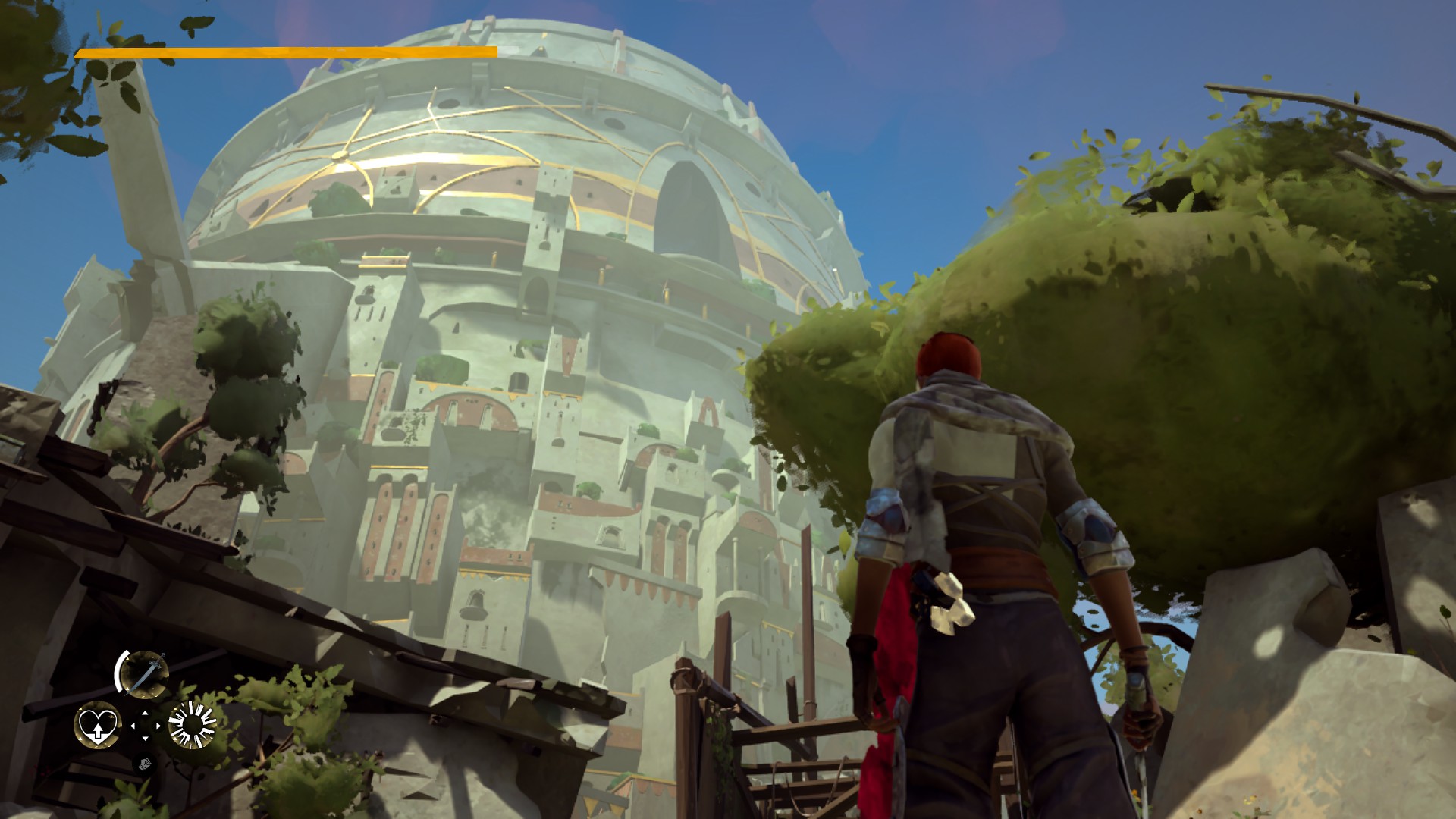
As well as gating PvE content behind PvP accomplishments, the Combat trials are one of the only ways to get the sweet equipment. The lost prospects and marked ones you find in Adal have been there for a very, very long time. As a result, all their gear, all the loot you can get from them, is torn, broken, or worn down. It’s a neat idea, and the gear doesn’t look awful, but it’s impossible to get the vast majority of the sleeker looking versions without competing in the combat trials. The sleeker versions, denoted by a white glow behind the item in the equipment screen, are statistically strictly better: better damage reduction than the worn out versions, while adding almost no weight. But that’s not all! If you’re looking for a specific piece of gear, then you might be in PvP for a while. The gear drops you get every time you acquire a combat trial level are completely random, meaning you might not get that sweet, unbroken Shabu Guard coat for a very long time. Not that this is game breaking, honestly; the gear you find in the world is perfectly serviceable. It is, however, still an annoying design decision from the perspective of a timid, co-operative player like myself.
This all can leave a bad taste in the mouth if PvP isn’t what you want. If this were a normal fighting game, where the “story” is barely more than a thinly veiled excuse to have your character face the rest of the roster topped with a difficult boss at the end, then this problem wouldn’t be much of an issue. The thing is, Absolver’s main game world of Adal is an idea that defies that genre trope, and it’s emblematic of something Absolver is incredibly guilty of; exploring and creating a largely convincing and interesting beginning to certain ideas (in this case, a beautiful world with gobs of clever visual story telling), but then simply failing to explore that idea to its fullest potential. Although the combat mechanics are standalone amazing, the game pushes towards a wonderful and interesting adventuring experience as well. It presents the world of Adal as a fully fleshed out and interesting place at first, but then that experience ends, and it feels as if it were a prologue with no guaranteed follow up, and hides further content behind a PvP barrier that is daunting for some players, myself included.
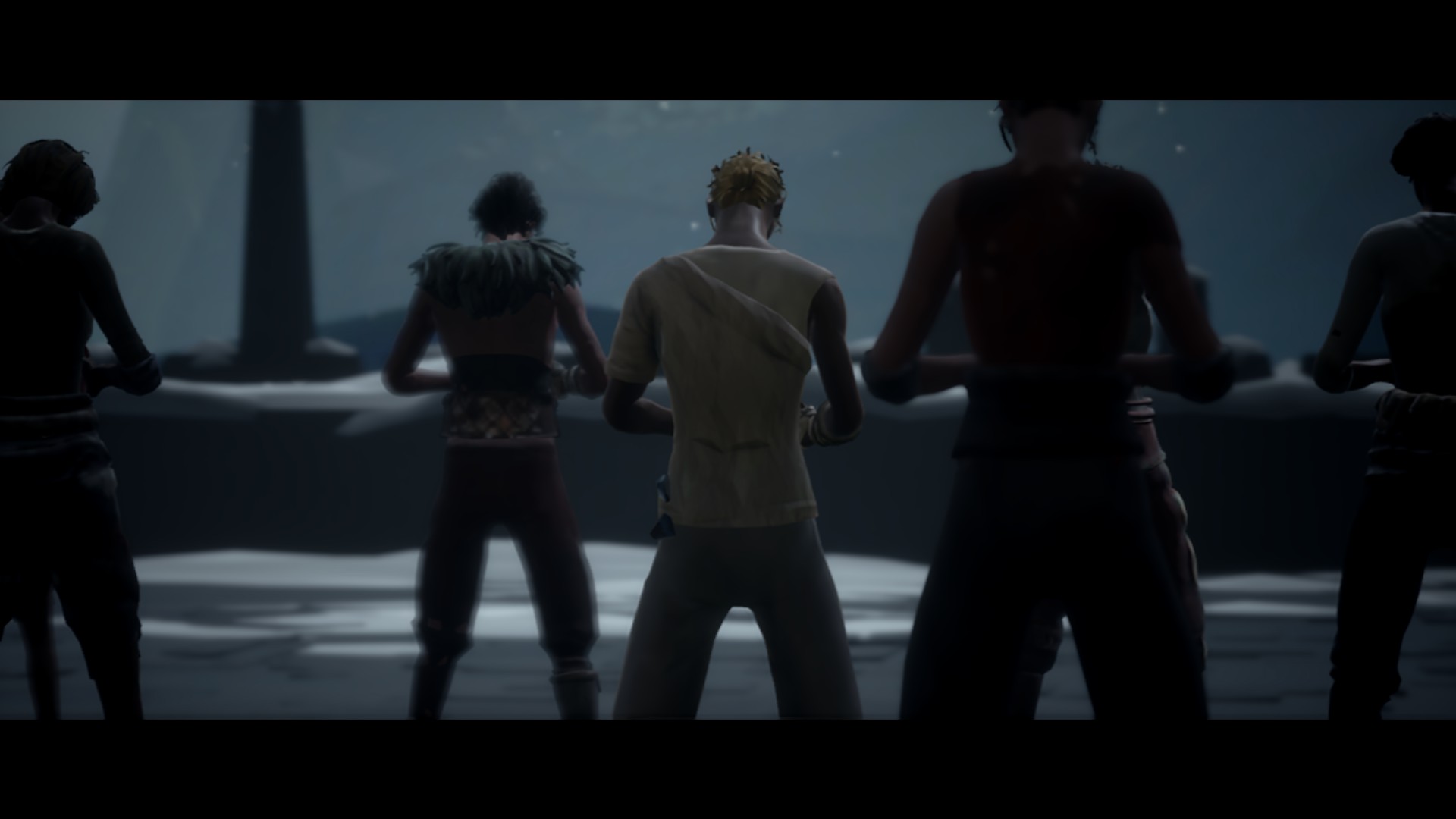
Still, I really love Absolver, and I mentioned one reason already; the combat mechanics. The second reason is the story telling that the developer, Sloclap, did their best to engineer: the player interactions. While out in the world, every section of the world works like a small instance with a revolving door of people that leave and enter, with a maximum of 3 people being in any one area at a time. Unlike an MMO where seeing another player is a dime-a-dozen moment, Absolver’s player interactions are unique opportunities for emergent gameplay. It’s a genuine feeling of the unknown; players can attack you at any time, whether in co-op mode or not. Coupled with a seemingly deliberately minimal emote system, which is the only non-violent means of communication, Absolver’s playerbase must make their actions speak for them.
It’s not uncommon to be moving around the world and find someone else, but every situation has the potential to be a unique story. Sometimes it can be co-operation; early on in my first playthrough, a met a player called Darkling. Darkling was fighting a CPU, and I decided to help. It wasn’t hard, as a 2 on 1 is usually a simple affair, but Darkling seamed pleased with the assistance. We made a party and then proceeded to clear out the entire Forgotten Temple, including the marked one there. We didn’t stop there though; Darkling and I somehow managed to stick together, fighting through to the Bird Callers Outpost. We helped each other out of sticky situations, overcame bad matchups, and defeated another marked one. For being one of the first player interactions I had, I was thrilled. We continued together only to find that the next region, the Adalian Columbary, was a boss each player had to fight alone. I was genuinely sad to move on, and as Darkling vanished into the instance smoke I found myself thinking how truly unique that experience was.
Other times, experiences can be more confusing. Wandering through the central harbour, I found a player battling CPUs. I decided to attack the CPU, to help the human player, but the player turned on me instead, nearly killing me. I ran, and managed to find a quiet corner to quickly recover. Once I was ready to venture out into the harbour again, I found the same player attacking someone else. No one was bullying inexperienced players on my watch, I thought, and so I attacked the turncoat from before. It wasn’t so simple, however; the other player then turned on me as well. I maneuvered my way out of there, and watched as the two of them returned to attacking one another. That was enough from those people for one day, and I made my way to a completely different area.
Another time, I was standing in the Oratian Quarter on top of one of the buildings, admiring the view. It’s truly still a spectacular world, and I was appreciating that I could see the coloseum and the harbour, the neighbouring areas, by using a high vantage point, an actual navigation technique. And then, a random player just attacked me from behind, almost pushing me off the edge of the building. Swinging around with a dodge, I immediately broke into several kicks and then backed off. A bright flash of light later, I stood with my sword in hand, and waited to see his response. Several moments passed. Eventually, his stance relaxed, and I dropped my focus and folded my sword away. I gave him a thumbs up, the “yeah” emote. The other player hung his head, slumped his shoulders (the “sad” emote), and without warning ran off the edge of the building, killing himself. He ran by a few moments later after respawning without so much as a wave, and continued on his way. I hadn’t laughed so hard in days.
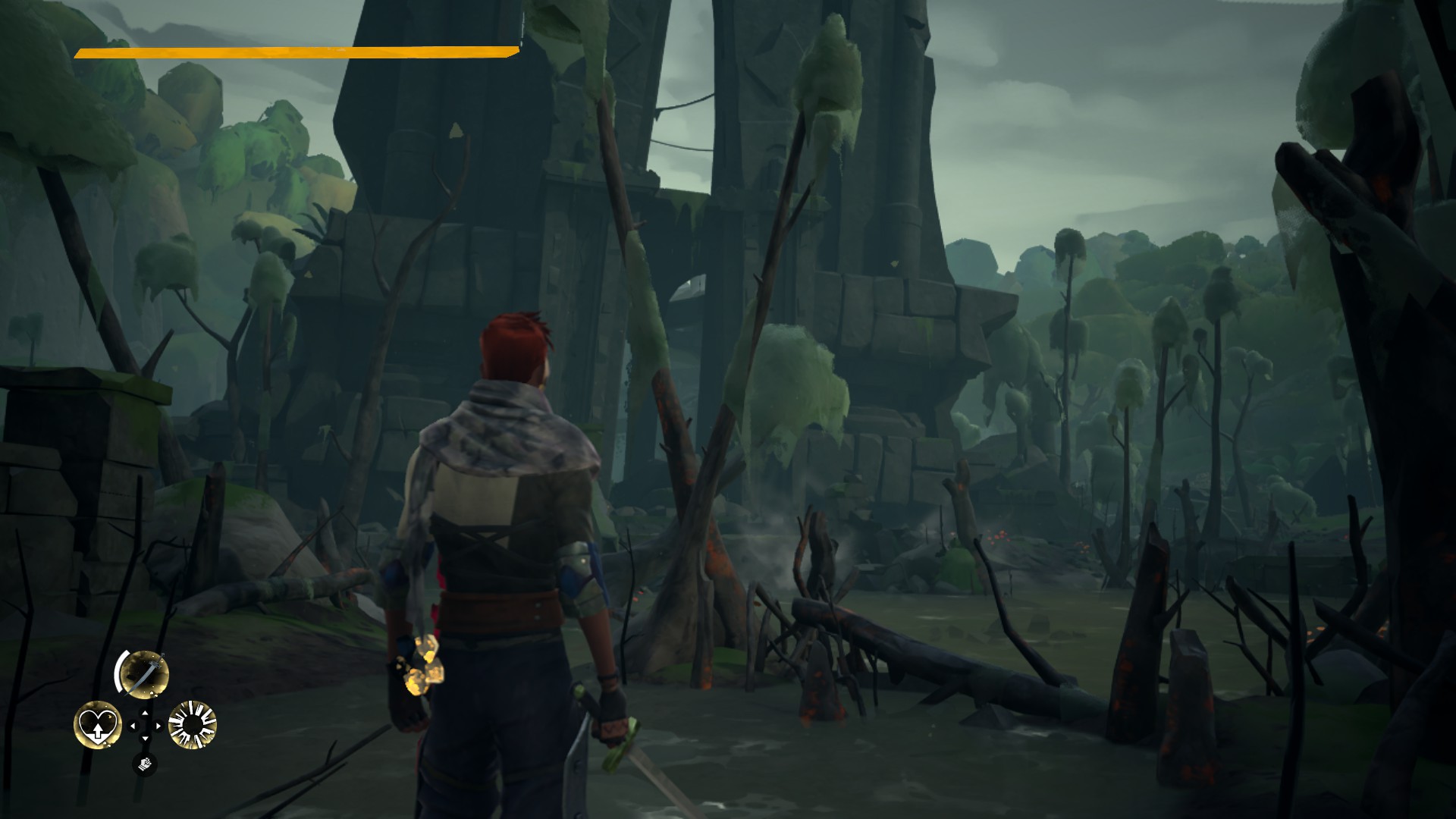
Probably my favourite moment was much later on. I was wandering through the world, having become an Absolver, and was learning new moves when I came across a player who was engaged with 5 CPU fighters. I did my best to help, but nothing went as planned: sword strikes went awry and cut the person I was trying to help. I folded the sword away, but it was at this point that my spin-kick heavy combat deck was a danger to everyone around me. I accidentally killed the player I had meant to help, and reduced the number of CPU fighters to only a couple left. The player from earlier respawned and found his way back, attacking the CPU players from behind. Once they were dealt with, the other player punched me several times and fell back. I didn’t retaliate; instead, I relaxed my stance and bowed, and tried to convince them through a sad emote and a shrug that it was a mistake. The player jabbed me once more, and then went off on their own.
I thought that’d be the end of it, but it wasn’t; I ran into the next instance, and saw them again; this time, in a 3 on 1 situation. I tried to help again, this time doing so without killing him, but it was obvious they were still ticked. They moved slowly around me, and were constantly in combat form. I figured that if I walked past, no problem; as I did so, they punched me exactly once, again. This time, I slapped them back, but then kept on going. Oddly, the other player followed me, and a strange “tit for tat” situation emerged, where they’d get a jab in if they could and then I’d do the same back.
This continued until we met the marked one inside the Forgotten Temple, Angrel, who had an ally; it was going to be an even 2 on 2 fight, which is exactly what happened. My “ally” tackled Angrel himself while I dealt with the other one. My duel was short, and I quickly turned towards Angrel, who has my “friend” in a corner. I was careful this time to only attack when it wouldn’t hit the other player, and Angrel fell quickly. The dust settled, and it was just myself and the other player left. Several moments passed.
Then, out of the blue an official request for co-operation.
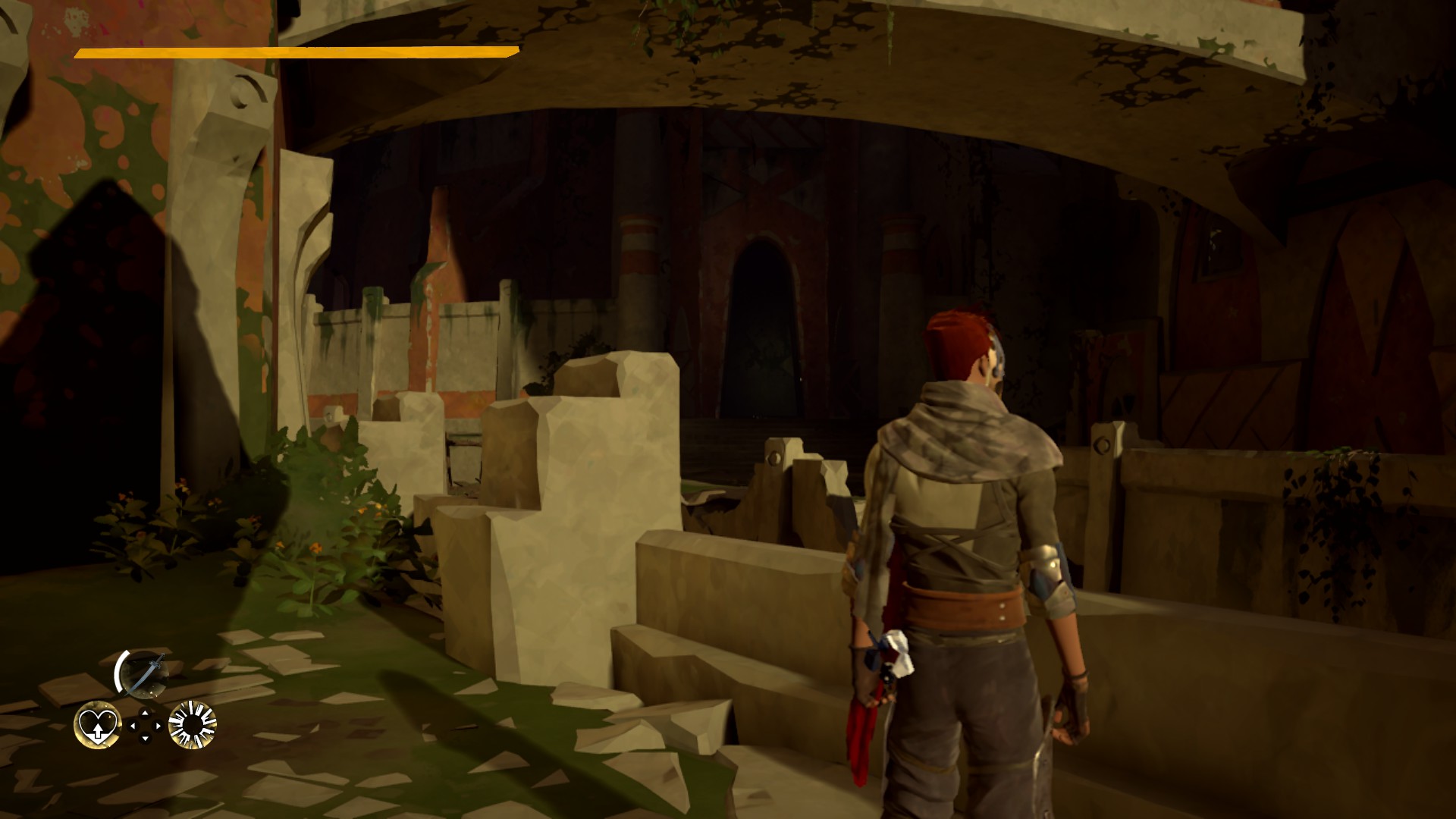
We ran around the temple, and I showed them where to find a silly mask, a couple of shortcuts around the swamp, and how to get to the bird caller’s outpost. They had no idea where all this stuff was, a completely new player, and here I was mentoring them! After such a rocky start, we started making a great little team. I switched combat styles and changed my combat deck to be more precise, and things went swimmingly. There were even a couple of tense moments, where one of us would die leaving the other player to finish the fight alone. I showed them where to find all the cairns containing loot in the area, and then fought Ama Saba, the marked one in the Outpost. Ama Saba had two allies, which meant it was a 3 on 2. It came down to the wire at several points.
I decided to handle the two lackeys while my partner duked it out with Aba Saba herself. Thing is, I was having a hard time, and only barely managed to defeat the two extras. That’s when I noticed that my partner was on their last sliver of life, while Aba Saba was sitting at almost 3/4s of hers. Rushing to attack the marked one, Aba Saba killed my partner. I pummeled the marked one away, and blasted her off the stairs we were on with a shockwave; not a tall fall, mind you, but it bought enough time that I could resurrect my friend. From there on the fight went well, as we took turns attacking Aba Saba. Eventually she fell: we had won. It was a good fight.
The only area left to go to for them was the Adalian Columbary, the same place I’d parted ways with Darkling all that time ago. I escorted the other player up the cliffside, to the sunset-soaked columbary. After showing them the altar nearby, I bowed and did the “sad” emote. They motioned to come follow them, and then vanished into the boss instance. They didn’t know it was a solo experience; a very sudden goodbye.
I hope they did well.
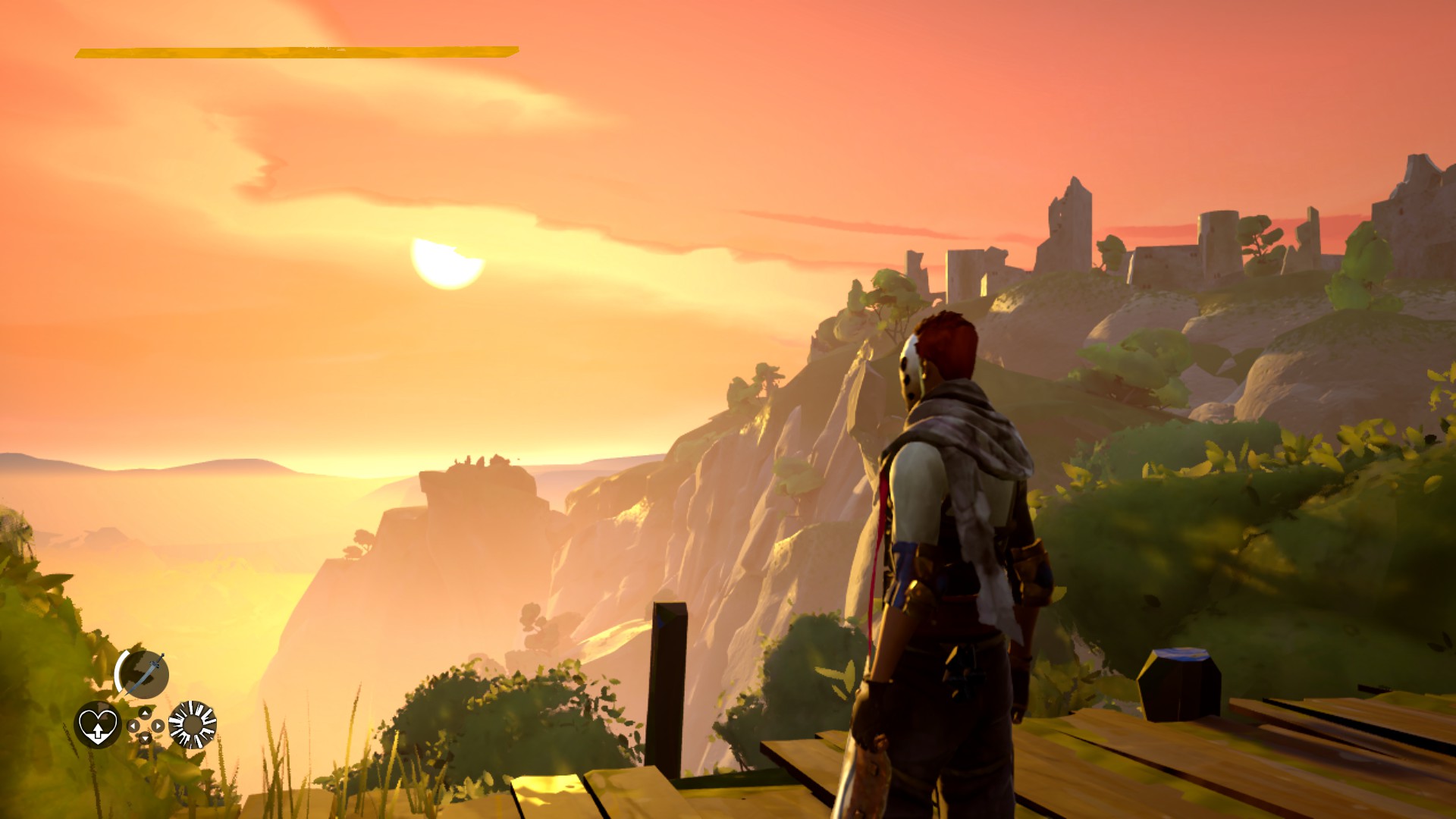
It’s these stories that really make Absolver memorable; little player dependent experiences that evolve from player behaviours. It’s great that Absolver sets this up and lets players figure things out. In fact, the lack of hand holding and concrete boundaries to behaviour (outside of the no talking facet of things) is remarkable; co-op mode doesn’t remove friendly fire at all, and can be broken if a player attacks their partners too many times. It’s fluid and allows players to change their mind on a whim. It allows players to explore and express the game’s primary mechanic in a variety of ways without judging the player in any particular way. Do you want to help others, or hurt them? And what if they refuse your help? Absolver’s story doesn’t want to focus on the Adalian Empire, the Downfall, or whatever passes as a prescriptive story here. Absolver is focused on instead on setting up the very human interactions between players. Absolver provides the setting and the initial encounter; the player is the one who determines what happens from there. It’s a good setup, and the instanced multiplayer combined with the small regions all but guarantees these kinds of encounters between players. Additionally, because learning new moves is largely going to only happen in the world, this forces players of all skill levels to mix together.
But Absolver’s main issue kicks in again. Though the emergent gameplay is frequent, Sloclap is still relying on the players to do the majority of the work here. If players aren’t invested, and just run on by without interacting, the system falls apart. Player investment isn’t guaranteed by any stretch, and Sloclap are gambling hard on the fickle nature of people to create the emotional ties necessary to keep players interested in the game.

Truly, at the end of the day, Absolver’s only 100% success is the combat system, though everything in the game seems to have been made with care; it’s just all feels as if it’s been left unfinished. The world of Adal is small, and quickly explored. Even hinted potential, such as when the player breaks down a door with a guardbreak attack during the tutorial section of the game, is simply left unused and unexplored as a concept. In its rush to be a groundbreaking piece of work, Absolver’s ambitious attempts have tripped itself up and revealed plenty of ideas that haven’t been fully tapped, or ideas that have been throttled back to allow the combat a center stage it already would have had.
It’s not a bad game; not at all, in fact. Additionally, Sloclap are still currently developing Absolver for several months into the future, which is reassuring. I just find myself wishing that the developers had made a thoughtful game to be supported by the robust combat system, rather than a combat system showcased by some game. Although this may come across as fortune cookie nonsense, it’s clear to me that Absolver, though a strong and capable game, lacks focus and balance.
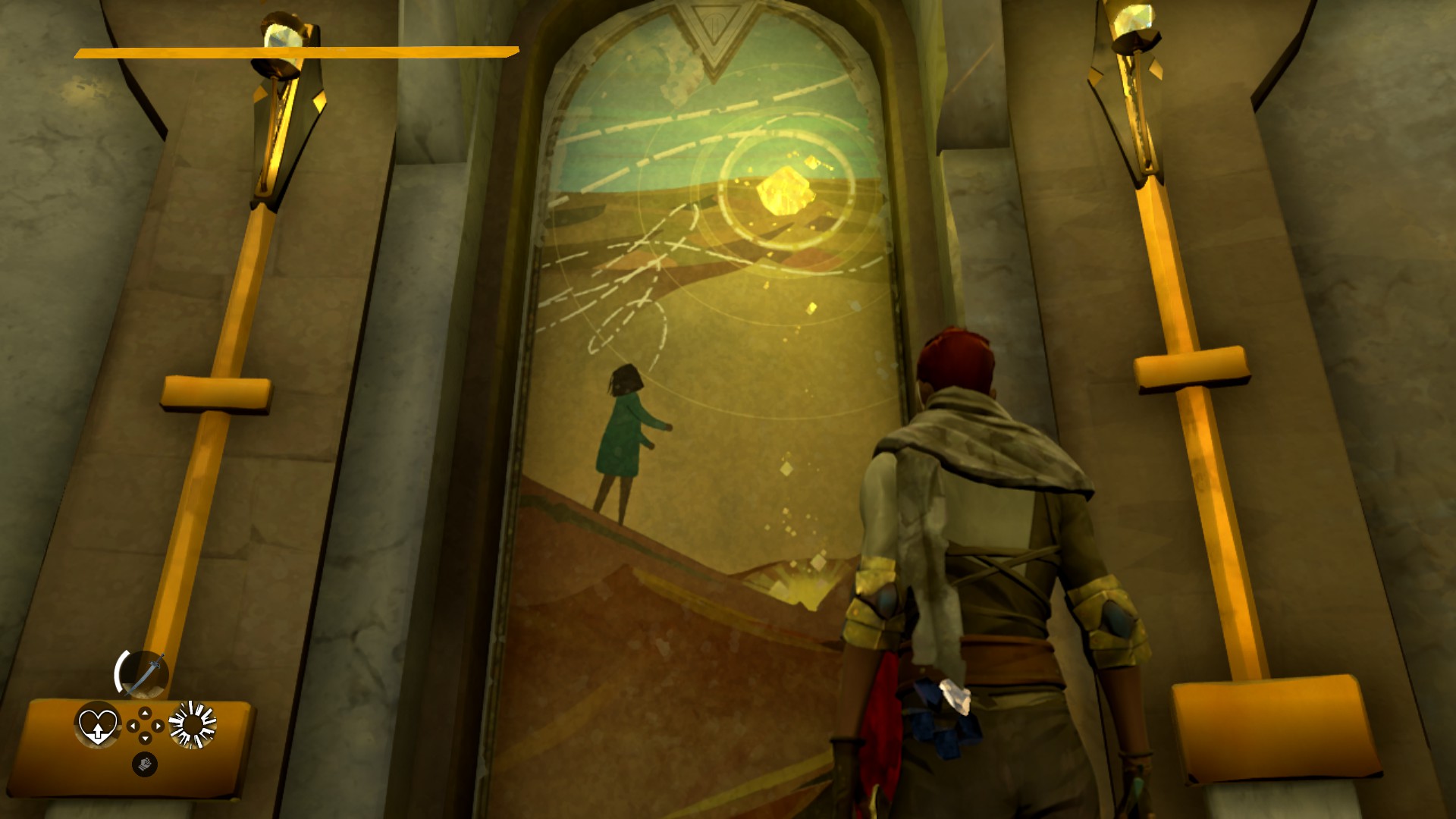
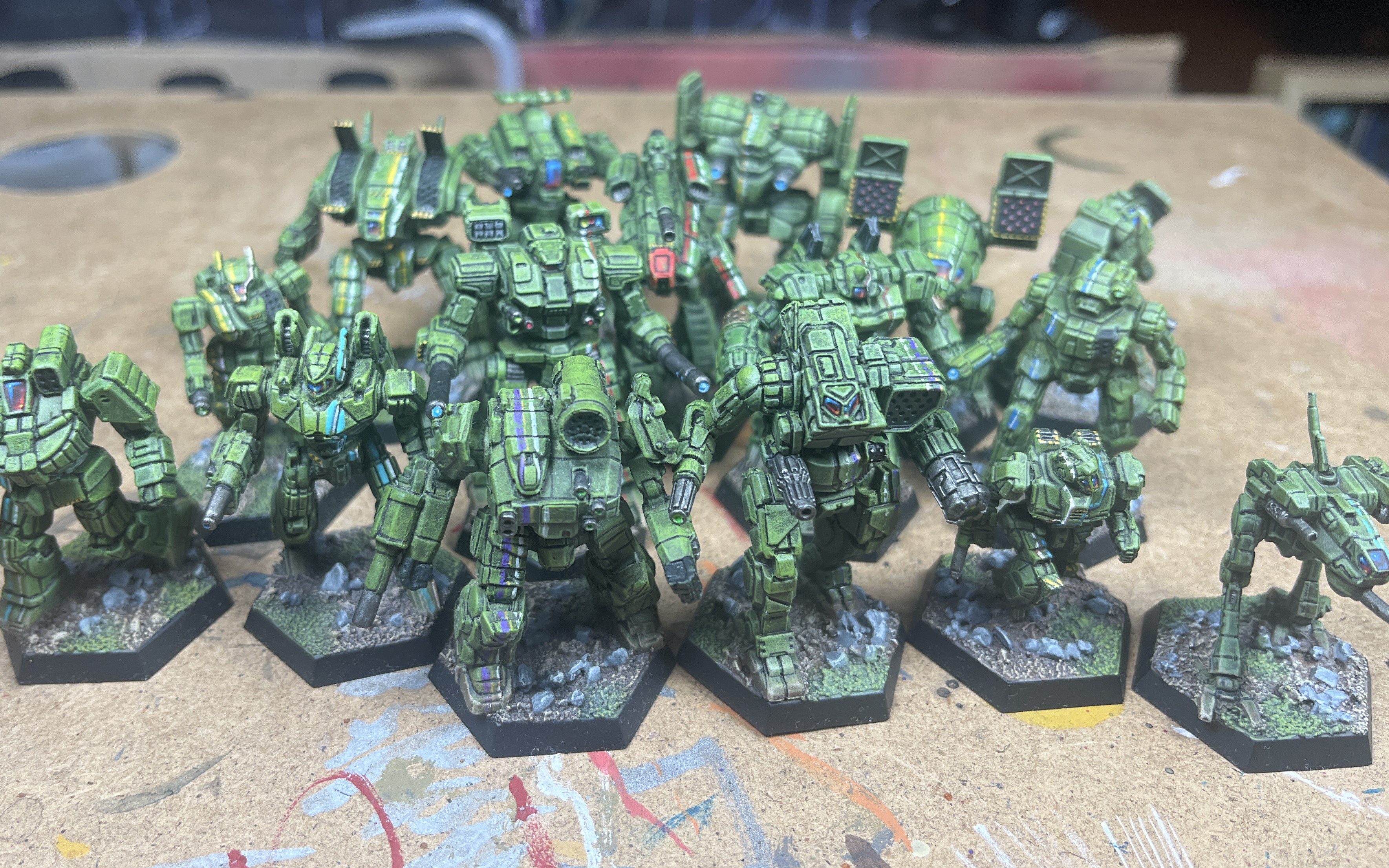



























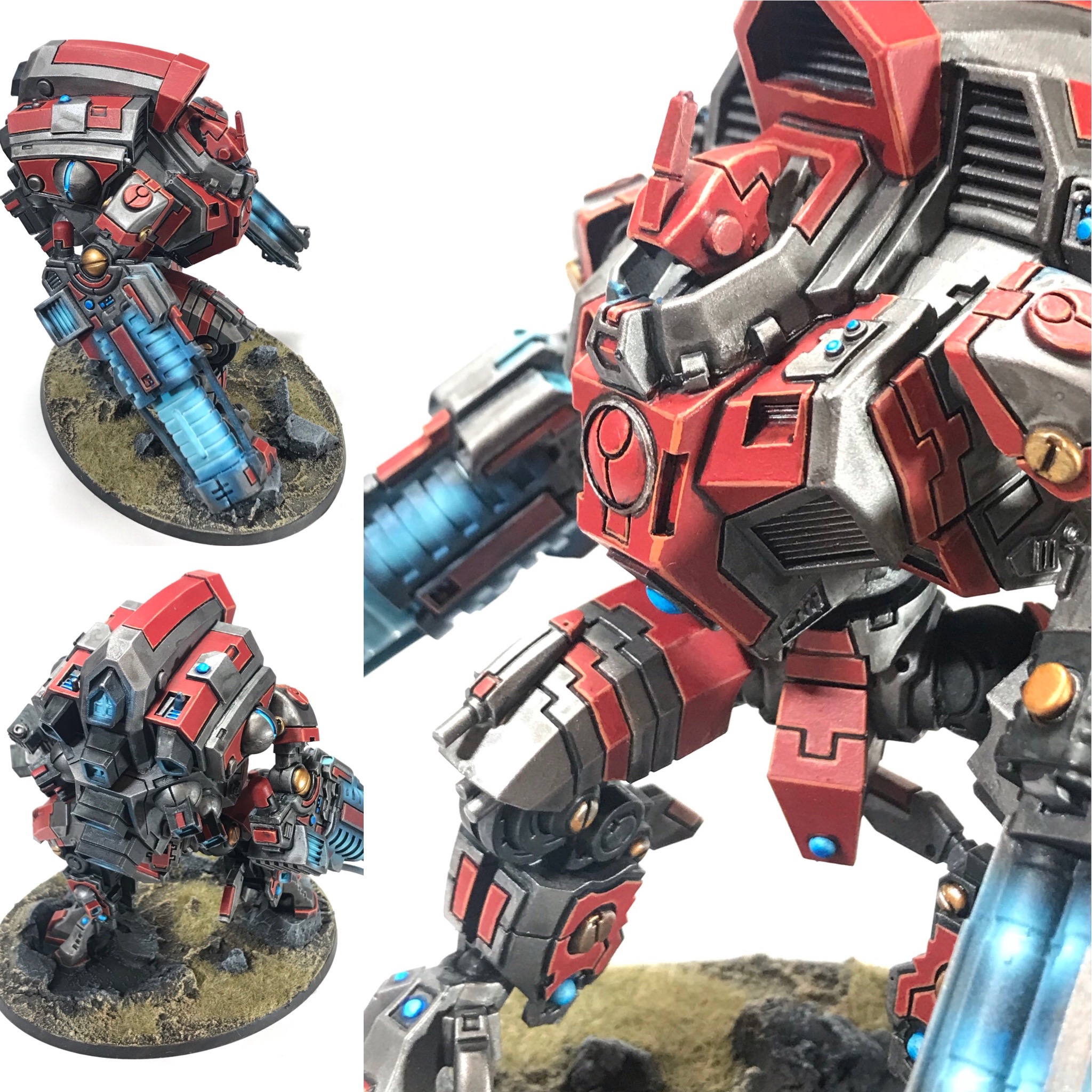
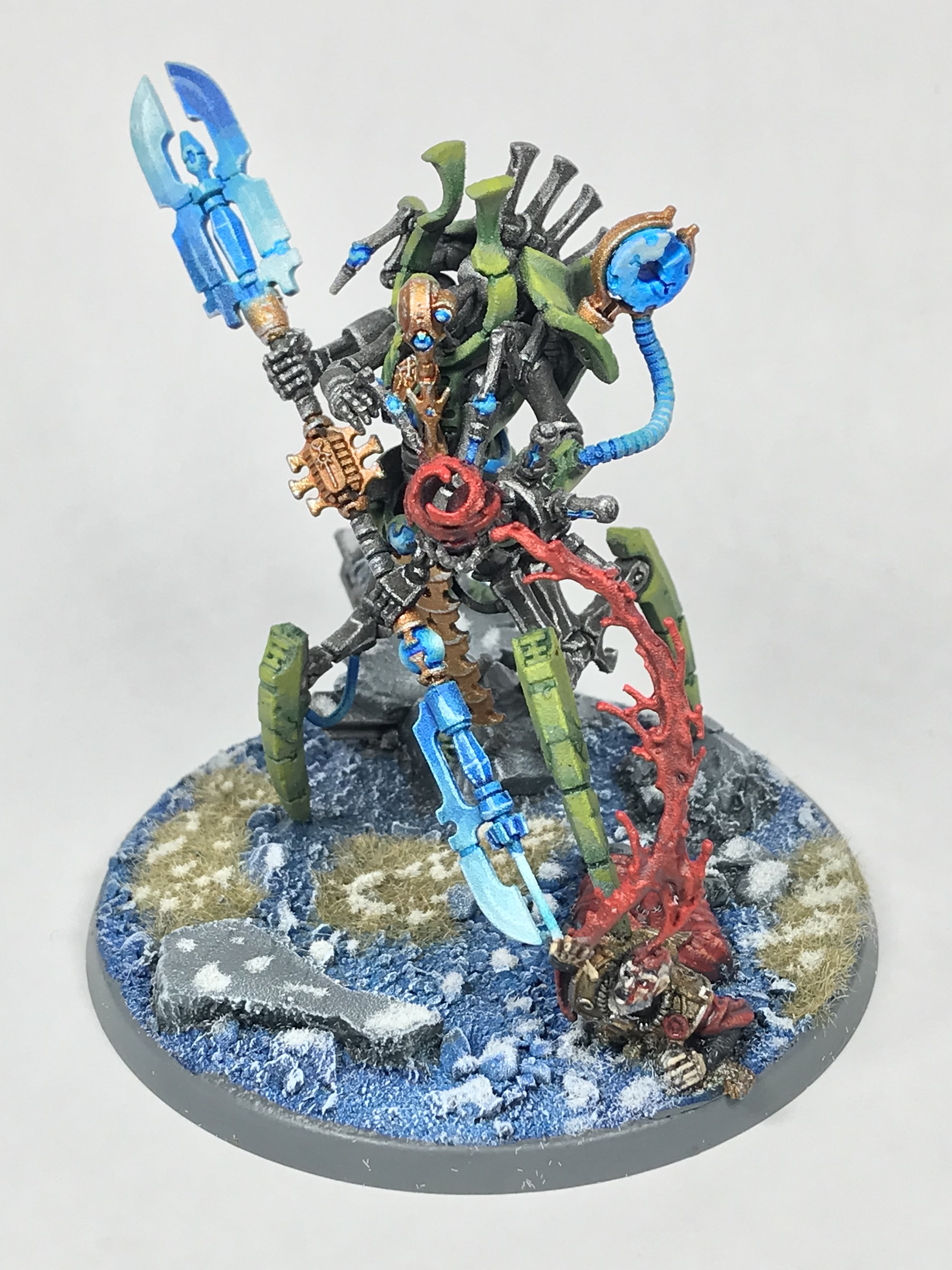
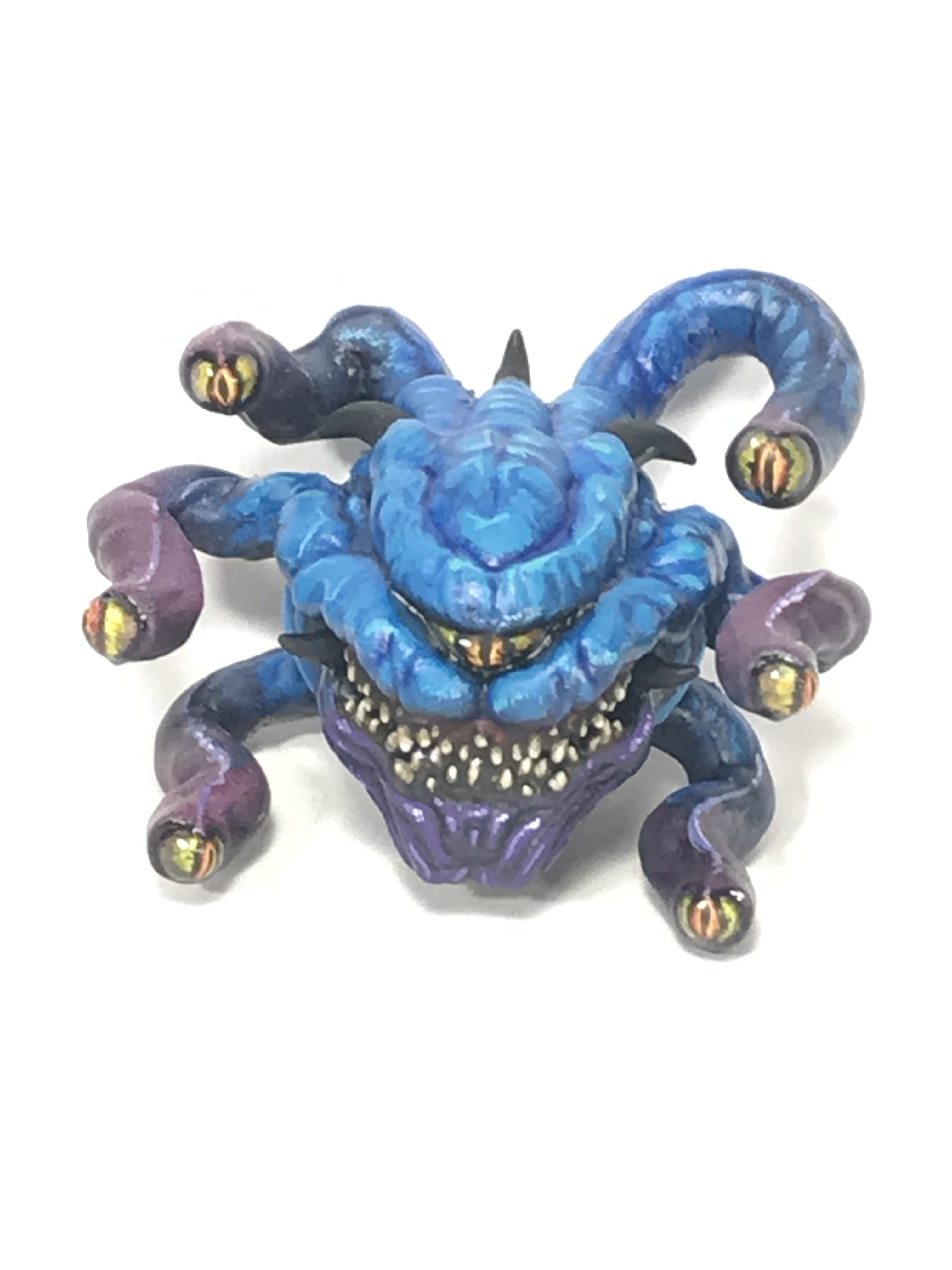
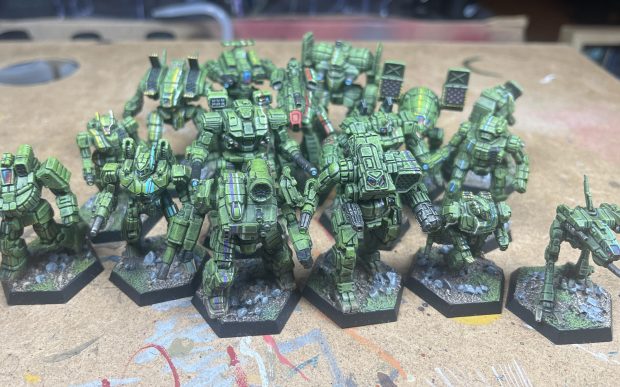
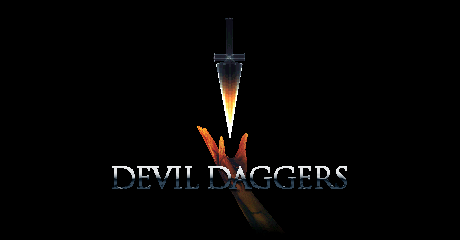
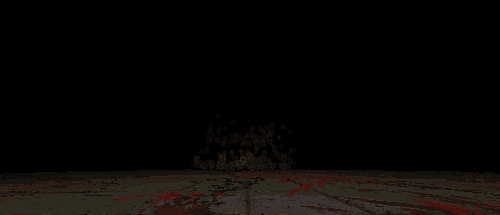
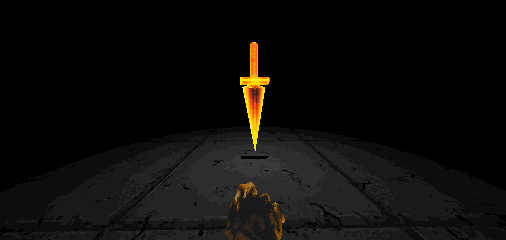
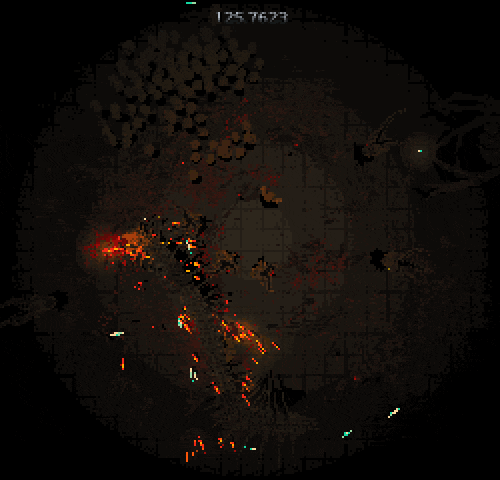
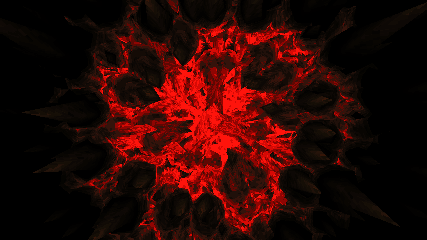
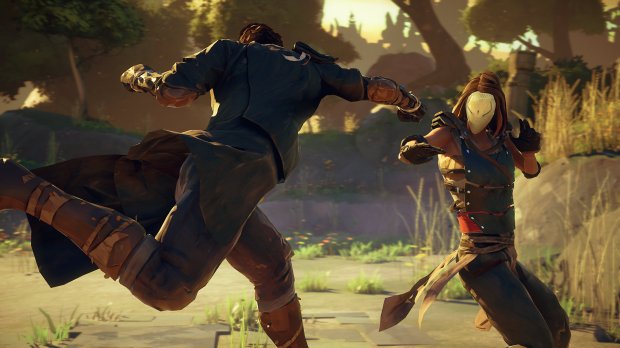





















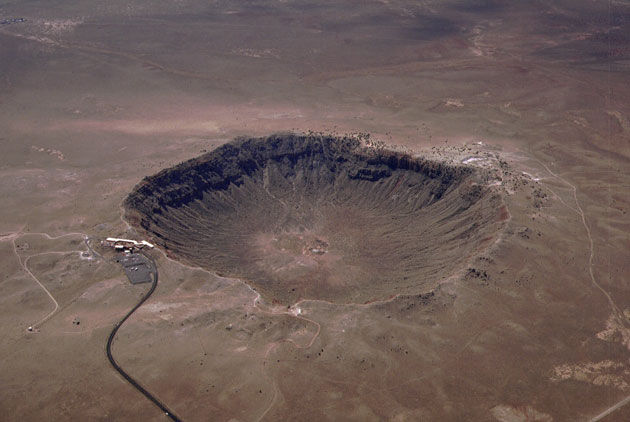
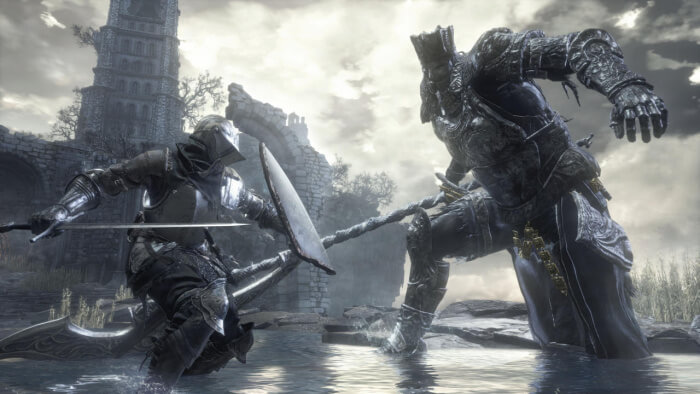

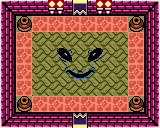
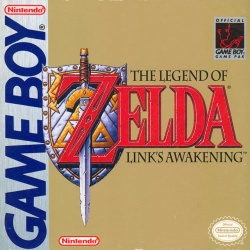 In my down time I’ve had the pleasure of being able to replay one of the most important games in my life: Link’s Awakening DX. I bought it on the virtual console for my 3DS, and it has been a great experience revisiting Koholint island. Link’s Awakening is the first game I ever played in my life, and it’s one of the few games that I can pick up more than a decade later and still remember. It’s like muscle memory, running through the dungeons, beating the nightmares, and getting all the little secrets I found out as a kid with the added bonus of, you know, not being an idiot and finding the rest of them.
In my down time I’ve had the pleasure of being able to replay one of the most important games in my life: Link’s Awakening DX. I bought it on the virtual console for my 3DS, and it has been a great experience revisiting Koholint island. Link’s Awakening is the first game I ever played in my life, and it’s one of the few games that I can pick up more than a decade later and still remember. It’s like muscle memory, running through the dungeons, beating the nightmares, and getting all the little secrets I found out as a kid with the added bonus of, you know, not being an idiot and finding the rest of them.
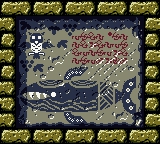
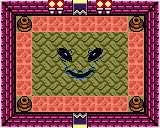
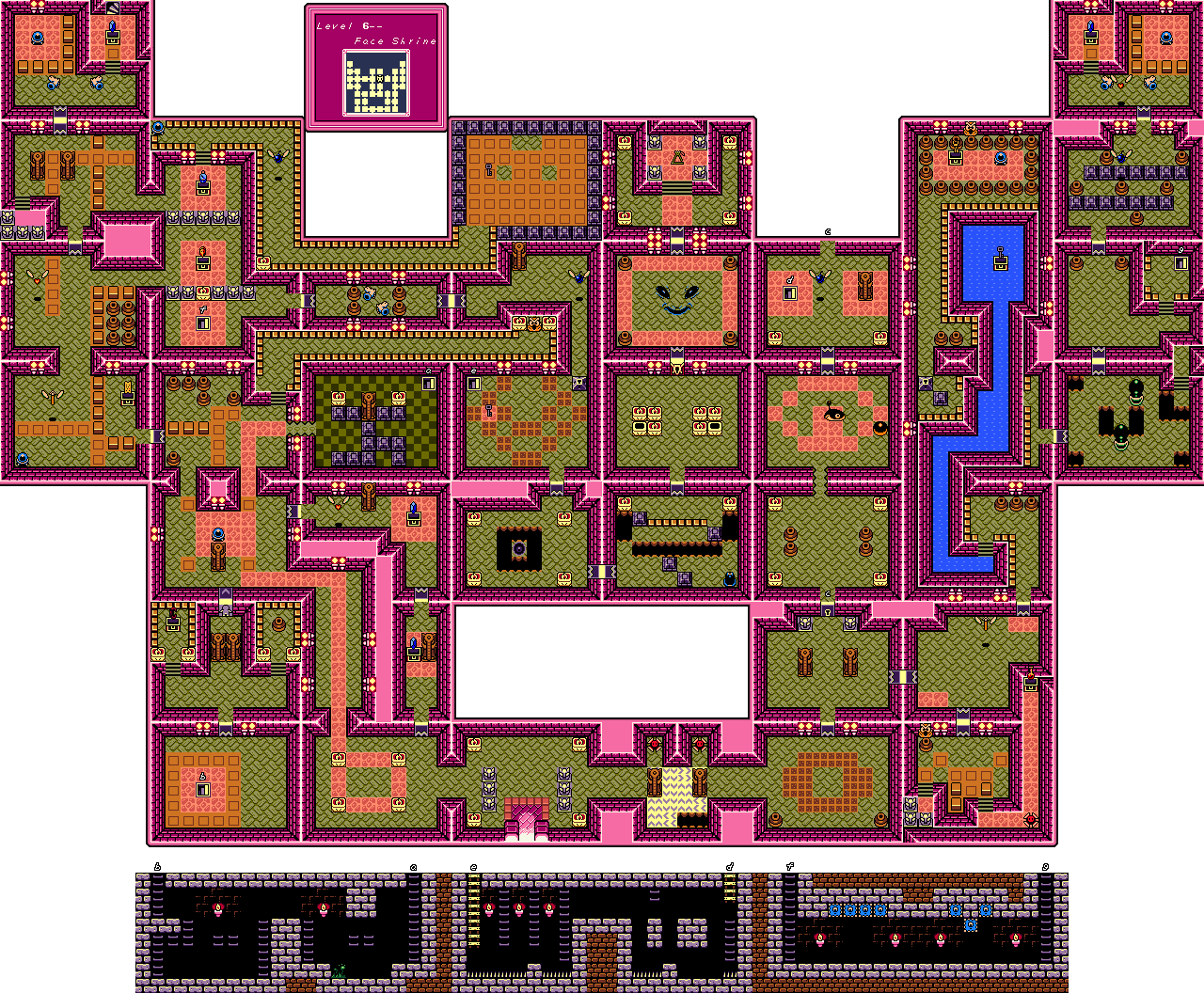 Playing it through a second time, you pick up on a couple more things. For instance, you notice that the dungeon layout is Link’s face from the first Legend of Zelda (this kind of obvious dungeon layout stuff isn’t new in the game: Key Cavern was in the shape of two keys, Bottle Grotto was a bottle, Tail Cave had a tail, etc). Part of the dungeon involves figuring out the riddle from earlier about the eyes. The left eye in the dungeon is easy enough: there’s a path that leads right to a spot on the wall you have to bomb, and the Map shows there’s a doorway there. Entering this room shows you the Ganesha tribute in the dungeon. Getting into the right eye took some faith: after unlocking the room right before the eye (which ends up being the mini boss of the dungeon), there’s a small combat and then… it’s an empty room. No indicating markings for anything anywhere. You poke all the walls with your sword to hear the sound it makes because in this game, if you poke a bombable wall, it makes a different ping noise than usual. None of the walls make the unusual ping, so you have to guess that there is a wall you can bomb. Eventually the riddle kicks in and you bomb your way up, and you move forward.
Playing it through a second time, you pick up on a couple more things. For instance, you notice that the dungeon layout is Link’s face from the first Legend of Zelda (this kind of obvious dungeon layout stuff isn’t new in the game: Key Cavern was in the shape of two keys, Bottle Grotto was a bottle, Tail Cave had a tail, etc). Part of the dungeon involves figuring out the riddle from earlier about the eyes. The left eye in the dungeon is easy enough: there’s a path that leads right to a spot on the wall you have to bomb, and the Map shows there’s a doorway there. Entering this room shows you the Ganesha tribute in the dungeon. Getting into the right eye took some faith: after unlocking the room right before the eye (which ends up being the mini boss of the dungeon), there’s a small combat and then… it’s an empty room. No indicating markings for anything anywhere. You poke all the walls with your sword to hear the sound it makes because in this game, if you poke a bombable wall, it makes a different ping noise than usual. None of the walls make the unusual ping, so you have to guess that there is a wall you can bomb. Eventually the riddle kicks in and you bomb your way up, and you move forward. I’ve been sitting at home recently thinking about how long I’ve had my current logo. It’s a solid logo, and there’s absolutely nothing wrong with it; however, I’ve been getting an itch.
I’ve been sitting at home recently thinking about how long I’ve had my current logo. It’s a solid logo, and there’s absolutely nothing wrong with it; however, I’ve been getting an itch.